Paul van Yperen's Blog, page 36
October 13, 2024
Gardner McKay
American actor, artist, and author Gardner McKay (1932-2001) was best known for the lead role in the TV series Adventures in Paradise (1959-1962), based loosely on the writings of James Michener. He quit acting and became a writer in 1970.
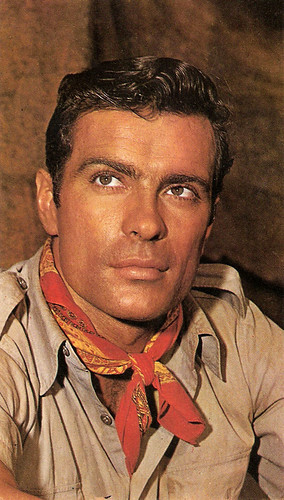
French postcard by Publistar, offered by Corvisart, Epinal, no. 919. Photo: United-Press.
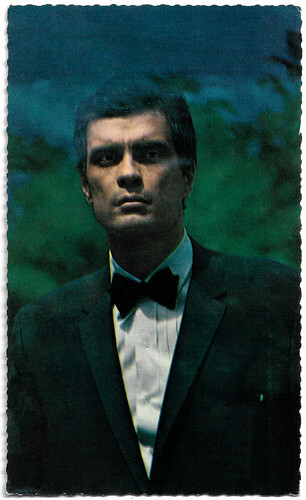
French postcard by Publistar, Marseille, for Corvisart, Epinal, no. 1120. Photo: Philippe d'Argence.
Man about town
George Cadogan Gardiner McKay was born in 1932 in New York City. 'Gard' was the son of ad executive Hugh Deane McKay and socialite Catherine 'Kitty' Gardner McKay. His father's business took the family to Paris, where McKay attended private schools. The family returned to the United States shortly before the outbreak of World War II.
McKay and his older brother, Hugh, lived with their grandparents in Lexington, Kentucky. He attended Cornell University in Ithaca, New York for two years, where he majored in art. He wrote for The Cornell Daily Sun and the campus magazine. He dropped out of school at the age of 19 following the death of his father and moved to Greenwich Village where he worked as a sculptor and writer.
McKay also took up photography and saw some of his work published in The New York Times and Life magazine. McKay's sculpting appeared in the Museum of Modern Art in New York, and at an exhibit of his work, McKay attracted the attention of photographer Richard Avedon. Avedon invited McKay to Paris to shoot a series of photographs with models Suzy Parker and Barbara Mullen, cavorting in Paris bistros and nightclubs. The photo series led to a modelling career.
Town and Country magazine did a piece on McKay and his sculptures in its 'Man About Town' section, which led to an offer from an agent. McKay impressed producer Dore Schary, who signed him to a contract with MGM. For that studio, he played in episodes of The Thin Man (1957) and appeared uncredited in the film Raintree County (Edward Dmytryk, 1957), with Elizabeth Taylor and Montgomery Clift .
McKay left MGM and had television guest roles on Death Valley Days (1958), The Silent Service (1958), and Jefferson Drum (1958). In 1957–1958, McKay played United States Army Lieutenant Dan Kelly in the 38-episode syndicated Western series Boots and Saddles, with co-stars Jack Pickard and Patrick McVey. At 20th Century Fox, he screen-tested for a TV series based on The Gunslinger but failed to get the role. The test did, however, net him a long-term contract at the studio.
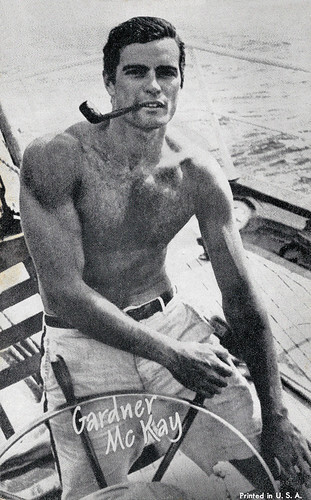
American Arcade postcard. Gardner McKay in Adventures in Paradise (1959-1962).
An extraordinarily handsome guy
Gardner McKay was spotted at the studio coffee shop by Dominick Dunne who was searching for an actor to star in his planned TV series Adventures in Paradise. Dunne later said, "I didn't know who he was. He was an extraordinarily handsome guy. I said, 'Are you an actor?' I gave him my card and said, 'If you're interested, call me.'"
McKay called, and ten actors were tested for the role. Dunne said of McKay: "His (test) was the worst, but everybody reacted to him, I mean everybody – especially the women." Although previously unknown to the public, McKay was featured on the cover of the 6 July 1959 issue of Life just two months before the series premiered. The article noted that he had been around boats since childhood and was an experienced seaman.
His character in Adventures in Paradise, Adam Troy, is a Korean War veteran who purchased the two-masted 82-foot (25 m) schooner Tiki III and sailed the South Pacific. The show ran for three seasons on ABC from 1959–1962, for a total of 91 episodes. During the series' run, McKay had bit roles in the Fox films Holiday for Lovers (Henry Levin, 1959) with Clifton Webb and The Right Approach (David Butler, 1961) starring Frankie Vaughan .
McKay returned to Hollywood in 1963 and had a support role in Fox's The Pleasure Seekers (Jean Negulesco, 1964) starring Ann-Margret . "It took me 100 hours to become a good actor," McKay later said. "Then I committed professional suicide." McKay had just decided to end his acting career, when he got a phone call from the noted director George Cukor, offering him the opportunity to star in a romantic comedy film opposite Marilyn Monroe .
The film was Something's Got to Give. McKay had made up his mind and turned it down. Cukor and Monroe were shocked. Monroe phoned him to see if she could get him to change his mind. McKay said, "She was so delightful on the phone, so winning, so seductive in a way," but he said no. He added, "I didn’t belong in acting." The part went to Dean Martin and the film was never completed. McKay's final film was I Sailed to Tahiti with an All Girl Crew (Richard L. Bare, 1968).
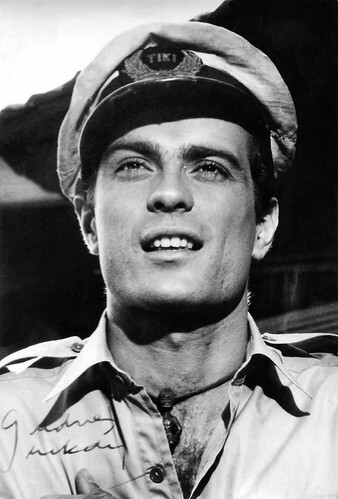
Vintage autograph card. Photo: Gardner McKay in Adventures in Paradise (1959-1962).
Leaving Hollywood
Gardner McKay sailed in the Caribbean and South America for a year and a half. "Not doing anything really," he said later. "I didn't give myself an excuse for being there." He moved to Paris, where he had lived as a boy. McKay left Hollywood to pursue his interest in photography, sculpture, and writing. Besides holding individual exhibitions, he exhibited his sculpture at the Museum of Modern Art in New York City.
His lifeboat rescue photographs of the Andrea Doria were published internationally. McKay wrote many plays and novels and was a literary critic for the Los Angeles Herald Examiner between 1977 and 1982. He taught writing classes at the University of California at Los Angeles, the University of Southern California, the University of Alaska, and the University of Hawaii.
He co-directed and wrote the TV film Me (Gardner McKay, Allan Muir, 1973) and wrote the script for another TV movie, Sea Marks (Ron Maxwell, Steven Robman, 1976), based on his play 'Sea Marks'. His play 'Toyer' was produced by the Arena Players Repertory Theater in New York in 1993 and in London at the Arts Theatre in 2009. Gardner bought a wooded property in Beverly Hills and kept a menagerie of animals including lions, cheetahs, dogs, and a monkey which he brought back from his sojourn to South America.
McKay's awards included three National Endowment for the Arts fellowships for playwriting, the Drama Critics Circle Award for Best Play, and the Sidney Carrington Prize. He was a winner of the Canadian Regional Drama Festival and runner-up in the Hemingway Short Story Contest. Gardner McKay settled in Hawaii, where he died in Honolulu from prostate cancer in 2001 at the age of 69.
He was survived by his wife since 1980, Madeleine Madigan, a painter, and two children, son Tristan and daughter Liza. Gardner is buried in Kentucky. Gardner Mckay is immortalised in the Jimmy Buffett song 'We Are the People Our Parents Warned Us About' (1983) that appeared on his 'One Particular Harbour' album with the line "Hey hey, Gardner McKay... Take us on the Leaky Tiki with you... Clear skies bound for Shanghai".
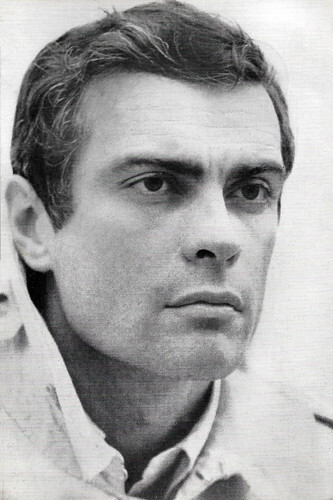
French promotion card. Photo: G. Neuvecelle / Columbia / EMI. Sent by mail from Martinique to France in 1965.
Sources: Wikipedia and .

French postcard by Publistar, offered by Corvisart, Epinal, no. 919. Photo: United-Press.

French postcard by Publistar, Marseille, for Corvisart, Epinal, no. 1120. Photo: Philippe d'Argence.
Man about town
George Cadogan Gardiner McKay was born in 1932 in New York City. 'Gard' was the son of ad executive Hugh Deane McKay and socialite Catherine 'Kitty' Gardner McKay. His father's business took the family to Paris, where McKay attended private schools. The family returned to the United States shortly before the outbreak of World War II.
McKay and his older brother, Hugh, lived with their grandparents in Lexington, Kentucky. He attended Cornell University in Ithaca, New York for two years, where he majored in art. He wrote for The Cornell Daily Sun and the campus magazine. He dropped out of school at the age of 19 following the death of his father and moved to Greenwich Village where he worked as a sculptor and writer.
McKay also took up photography and saw some of his work published in The New York Times and Life magazine. McKay's sculpting appeared in the Museum of Modern Art in New York, and at an exhibit of his work, McKay attracted the attention of photographer Richard Avedon. Avedon invited McKay to Paris to shoot a series of photographs with models Suzy Parker and Barbara Mullen, cavorting in Paris bistros and nightclubs. The photo series led to a modelling career.
Town and Country magazine did a piece on McKay and his sculptures in its 'Man About Town' section, which led to an offer from an agent. McKay impressed producer Dore Schary, who signed him to a contract with MGM. For that studio, he played in episodes of The Thin Man (1957) and appeared uncredited in the film Raintree County (Edward Dmytryk, 1957), with Elizabeth Taylor and Montgomery Clift .
McKay left MGM and had television guest roles on Death Valley Days (1958), The Silent Service (1958), and Jefferson Drum (1958). In 1957–1958, McKay played United States Army Lieutenant Dan Kelly in the 38-episode syndicated Western series Boots and Saddles, with co-stars Jack Pickard and Patrick McVey. At 20th Century Fox, he screen-tested for a TV series based on The Gunslinger but failed to get the role. The test did, however, net him a long-term contract at the studio.

American Arcade postcard. Gardner McKay in Adventures in Paradise (1959-1962).
An extraordinarily handsome guy
Gardner McKay was spotted at the studio coffee shop by Dominick Dunne who was searching for an actor to star in his planned TV series Adventures in Paradise. Dunne later said, "I didn't know who he was. He was an extraordinarily handsome guy. I said, 'Are you an actor?' I gave him my card and said, 'If you're interested, call me.'"
McKay called, and ten actors were tested for the role. Dunne said of McKay: "His (test) was the worst, but everybody reacted to him, I mean everybody – especially the women." Although previously unknown to the public, McKay was featured on the cover of the 6 July 1959 issue of Life just two months before the series premiered. The article noted that he had been around boats since childhood and was an experienced seaman.
His character in Adventures in Paradise, Adam Troy, is a Korean War veteran who purchased the two-masted 82-foot (25 m) schooner Tiki III and sailed the South Pacific. The show ran for three seasons on ABC from 1959–1962, for a total of 91 episodes. During the series' run, McKay had bit roles in the Fox films Holiday for Lovers (Henry Levin, 1959) with Clifton Webb and The Right Approach (David Butler, 1961) starring Frankie Vaughan .
McKay returned to Hollywood in 1963 and had a support role in Fox's The Pleasure Seekers (Jean Negulesco, 1964) starring Ann-Margret . "It took me 100 hours to become a good actor," McKay later said. "Then I committed professional suicide." McKay had just decided to end his acting career, when he got a phone call from the noted director George Cukor, offering him the opportunity to star in a romantic comedy film opposite Marilyn Monroe .
The film was Something's Got to Give. McKay had made up his mind and turned it down. Cukor and Monroe were shocked. Monroe phoned him to see if she could get him to change his mind. McKay said, "She was so delightful on the phone, so winning, so seductive in a way," but he said no. He added, "I didn’t belong in acting." The part went to Dean Martin and the film was never completed. McKay's final film was I Sailed to Tahiti with an All Girl Crew (Richard L. Bare, 1968).

Vintage autograph card. Photo: Gardner McKay in Adventures in Paradise (1959-1962).
Leaving Hollywood
Gardner McKay sailed in the Caribbean and South America for a year and a half. "Not doing anything really," he said later. "I didn't give myself an excuse for being there." He moved to Paris, where he had lived as a boy. McKay left Hollywood to pursue his interest in photography, sculpture, and writing. Besides holding individual exhibitions, he exhibited his sculpture at the Museum of Modern Art in New York City.
His lifeboat rescue photographs of the Andrea Doria were published internationally. McKay wrote many plays and novels and was a literary critic for the Los Angeles Herald Examiner between 1977 and 1982. He taught writing classes at the University of California at Los Angeles, the University of Southern California, the University of Alaska, and the University of Hawaii.
He co-directed and wrote the TV film Me (Gardner McKay, Allan Muir, 1973) and wrote the script for another TV movie, Sea Marks (Ron Maxwell, Steven Robman, 1976), based on his play 'Sea Marks'. His play 'Toyer' was produced by the Arena Players Repertory Theater in New York in 1993 and in London at the Arts Theatre in 2009. Gardner bought a wooded property in Beverly Hills and kept a menagerie of animals including lions, cheetahs, dogs, and a monkey which he brought back from his sojourn to South America.
McKay's awards included three National Endowment for the Arts fellowships for playwriting, the Drama Critics Circle Award for Best Play, and the Sidney Carrington Prize. He was a winner of the Canadian Regional Drama Festival and runner-up in the Hemingway Short Story Contest. Gardner McKay settled in Hawaii, where he died in Honolulu from prostate cancer in 2001 at the age of 69.
He was survived by his wife since 1980, Madeleine Madigan, a painter, and two children, son Tristan and daughter Liza. Gardner is buried in Kentucky. Gardner Mckay is immortalised in the Jimmy Buffett song 'We Are the People Our Parents Warned Us About' (1983) that appeared on his 'One Particular Harbour' album with the line "Hey hey, Gardner McKay... Take us on the Leaky Tiki with you... Clear skies bound for Shanghai".

French promotion card. Photo: G. Neuvecelle / Columbia / EMI. Sent by mail from Martinique to France in 1965.
Sources: Wikipedia and .
Published on October 13, 2024 22:00
October 12, 2024
Anne Bancroft
Anne Bancroft (1931-2005) was an American stage and film actress. She made her breakthrough with the general public with her role as Mrs Robinson in The Graduate (1967). She also appeared in several films directed or produced by her husband, Mel Brooks.
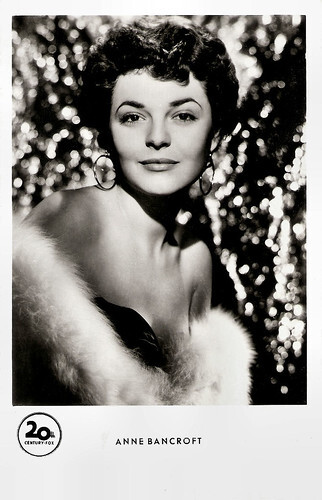
West-German postcard by Kunst und Bild, Berlin, no. A 1166. Photo: 20th Century Fox.
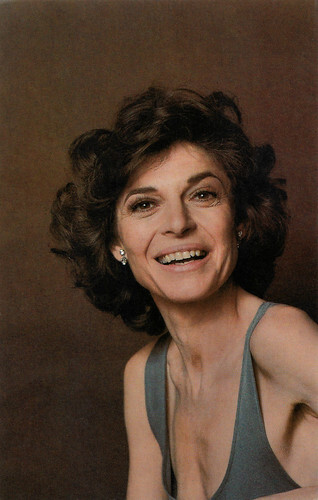
American postcard by Coral-Lee, Rancho Cordova, CA, no. Personality # 18, no. C32309. Photo: Douglas Kirkland. Caption: Anne Bancroft - Star of The Turning Point and other stage and cinematic successes. Ms. Bancroft is the wife of actor-writer-producer-comic Mel Brooks, October 1976.
To fulfil her dreams of becoming an accomplished stage performer
Anne Bancroft was born Anna Maria Louisa Italiano in The Bronx, New York, in 1931. She was the middle daughter of Michael Italiano, a dress pattern maker, and Mildred DiNapoli, a telephone operator.
She was trained at the AADA (American Academy of Dramatic Arts). As Anne Marno, she began her career on television in the 1950s. In 1952, she signed a contract with 20th Century Fox.
She was advised to change her surname for her debut, the Film Noir Don't Bother to Knock (Roy Ward Baker, 1952) with Richard Widmark and Marilyn Monroe . She chose Bancroft because she thought it was a dignified name.
After that, she played in the mediocre Sword and Sandal epic Demetrius and the Gladiators (Delmer Daves, 1954) starring Victor Mature , the Film Noir New York Confidential (Russell Rouse, 1955) starring Broderick Crawford and several B movies. By 1957 she grew dissatisfied with the scripts she was getting and after her contract with Fox expired, she left the film business.
Bancroft returned to New York where she enrolled in acting classes at HB Studios to 'unlearn' some of her film and TV techniques to fulfil her dreams of becoming an accomplished stage performer. In 1958 she won a Tony Award for her role in the play 'Two for the Seesaw' filmed in 1962. In 1960 she won another Tony for her role in 'The Miracle Worker' in 1959. Both plays were written by William Gibson.
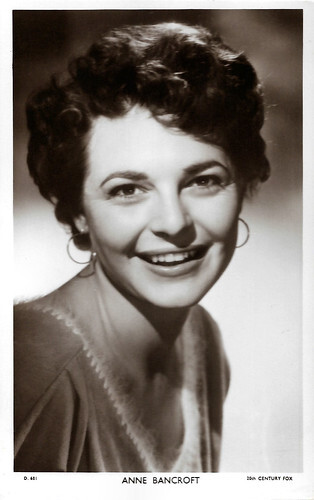
British postcard in the Picturegoer Series, London, no. D. 681. Photo: 20th Century Fox.
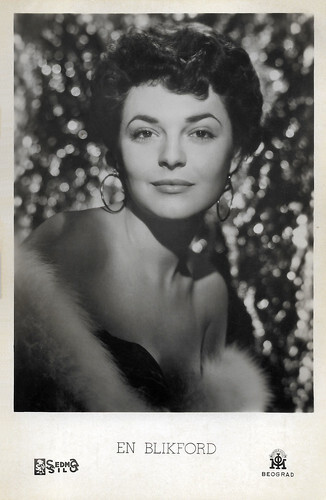
Yugoslavian postcard. Sedma Sila, Morava Film, Beograd (Belgrade). On this card, Bancroft's last name has turned into something only vaguely similar to her original name.
The ultimate 'older woman' who seduces her neighbour's boy
After these Broadway successes, Anne Bancroft returned to Hollywood, where she starred as Annie Sullivan in the film version of The Miracle Worker (Arthur Penn, 1962). She won an Oscar for it, but could not be at the presentation, as she was on Broadway at the time.
Bancroft went on to give acclaimed performances in The Pumpkin Eater (Jack Clayton, 1964) and The Slender Thread (Sydney Pollack, 1965) with Sidney Poitier . Her first husband, Martin May, was a lawyer from an oil-rich Texas family. In 1964, she married for the second time, this time to director Mel Brooks.
Her worldwide breakthrough was followed by The Graduate (Mike Nichols, 1967). In it, she played Mrs Robinson, the ultimate 'older woman', who seduces her neighbour's boy - the much younger Benjamin, played by Dustin Hoffman - into a sexual relationship. For this role, she was nominated for an Oscar. She gave birth to a son in 1972. She continued her career with such interesting films as Young Winston (Richard Attenborough, 1972), The Turning Point (Herbert Ross, 1977) with Shirley MacLaine , The Elephant Man (David Lynch, 1980) and To Be or Not to Be (Mel Brooks, 1983).
She made her directorial debut with the film Fatso (Anne Bancroft, 1980), starring Dom DeLuise. The film was financed by her husband's production company, Brooksfilm. She also started to make TV films, including Deep in My Heart (Anita W. Addison, 1999) for which she won an Emmy Award. Bancroft is one of the few people to have won 'The Triple Crown of Acting': an Oscar, a Tony and an Emmy. She is also one of the few actresses to win both an Oscar and a Tony for the same role. She was also Tony-nominated in 1978 for 'Golda', in which she played the title character, Golda Meir.
Anne Bancroft was again nominated for an Oscar for her roles in The Turning Point (Herbert Ross, 1977) and Agnes of God (Norman Jewison, 1985) with Jane Fonda . Her later career highlights include 84 Charing Cross Road (David Hugh Jones, 1987) as the American correspondent of Anthony Hopkins , Torch Song Trilogy (Paul Bogart, 1988) as the mother of Harvey Fierstein, and as one of the villagers in Waking Ned (Kirk Jones, 1998). In 2005, Anne Bancroft died of cancer in New York, at the age of 73. She is buried at the Kensico Cemetery in Valhalla, NY. Her final film was the animated feature Delgo (Marc F. Adler, Jason Maurer, 2008). It was released posthumously in 2008 and dedicated to her memory.
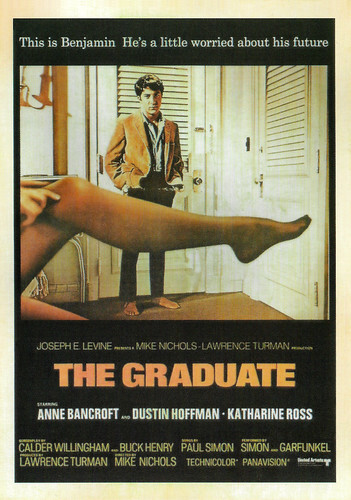
Vintage postcard. American poster by United Artists of The Graduate (Mike Nichols, 1967) with Dustin Hoffman and Anne Bancroft.
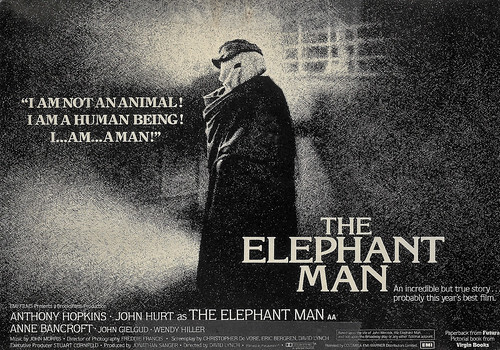
French postcard by Editions 'Humour à la Carte', Paris, no. A-C 91. British poster by EMI for The Elephant Man (David Lynch, 1980) with John Hurt, Anthony Hopkins and and Anne Bancroft.
Source: (IMDb), Wikipedia (Dutch) and .

West-German postcard by Kunst und Bild, Berlin, no. A 1166. Photo: 20th Century Fox.

American postcard by Coral-Lee, Rancho Cordova, CA, no. Personality # 18, no. C32309. Photo: Douglas Kirkland. Caption: Anne Bancroft - Star of The Turning Point and other stage and cinematic successes. Ms. Bancroft is the wife of actor-writer-producer-comic Mel Brooks, October 1976.
To fulfil her dreams of becoming an accomplished stage performer
Anne Bancroft was born Anna Maria Louisa Italiano in The Bronx, New York, in 1931. She was the middle daughter of Michael Italiano, a dress pattern maker, and Mildred DiNapoli, a telephone operator.
She was trained at the AADA (American Academy of Dramatic Arts). As Anne Marno, she began her career on television in the 1950s. In 1952, she signed a contract with 20th Century Fox.
She was advised to change her surname for her debut, the Film Noir Don't Bother to Knock (Roy Ward Baker, 1952) with Richard Widmark and Marilyn Monroe . She chose Bancroft because she thought it was a dignified name.
After that, she played in the mediocre Sword and Sandal epic Demetrius and the Gladiators (Delmer Daves, 1954) starring Victor Mature , the Film Noir New York Confidential (Russell Rouse, 1955) starring Broderick Crawford and several B movies. By 1957 she grew dissatisfied with the scripts she was getting and after her contract with Fox expired, she left the film business.
Bancroft returned to New York where she enrolled in acting classes at HB Studios to 'unlearn' some of her film and TV techniques to fulfil her dreams of becoming an accomplished stage performer. In 1958 she won a Tony Award for her role in the play 'Two for the Seesaw' filmed in 1962. In 1960 she won another Tony for her role in 'The Miracle Worker' in 1959. Both plays were written by William Gibson.

British postcard in the Picturegoer Series, London, no. D. 681. Photo: 20th Century Fox.

Yugoslavian postcard. Sedma Sila, Morava Film, Beograd (Belgrade). On this card, Bancroft's last name has turned into something only vaguely similar to her original name.
The ultimate 'older woman' who seduces her neighbour's boy
After these Broadway successes, Anne Bancroft returned to Hollywood, where she starred as Annie Sullivan in the film version of The Miracle Worker (Arthur Penn, 1962). She won an Oscar for it, but could not be at the presentation, as she was on Broadway at the time.
Bancroft went on to give acclaimed performances in The Pumpkin Eater (Jack Clayton, 1964) and The Slender Thread (Sydney Pollack, 1965) with Sidney Poitier . Her first husband, Martin May, was a lawyer from an oil-rich Texas family. In 1964, she married for the second time, this time to director Mel Brooks.
Her worldwide breakthrough was followed by The Graduate (Mike Nichols, 1967). In it, she played Mrs Robinson, the ultimate 'older woman', who seduces her neighbour's boy - the much younger Benjamin, played by Dustin Hoffman - into a sexual relationship. For this role, she was nominated for an Oscar. She gave birth to a son in 1972. She continued her career with such interesting films as Young Winston (Richard Attenborough, 1972), The Turning Point (Herbert Ross, 1977) with Shirley MacLaine , The Elephant Man (David Lynch, 1980) and To Be or Not to Be (Mel Brooks, 1983).
She made her directorial debut with the film Fatso (Anne Bancroft, 1980), starring Dom DeLuise. The film was financed by her husband's production company, Brooksfilm. She also started to make TV films, including Deep in My Heart (Anita W. Addison, 1999) for which she won an Emmy Award. Bancroft is one of the few people to have won 'The Triple Crown of Acting': an Oscar, a Tony and an Emmy. She is also one of the few actresses to win both an Oscar and a Tony for the same role. She was also Tony-nominated in 1978 for 'Golda', in which she played the title character, Golda Meir.
Anne Bancroft was again nominated for an Oscar for her roles in The Turning Point (Herbert Ross, 1977) and Agnes of God (Norman Jewison, 1985) with Jane Fonda . Her later career highlights include 84 Charing Cross Road (David Hugh Jones, 1987) as the American correspondent of Anthony Hopkins , Torch Song Trilogy (Paul Bogart, 1988) as the mother of Harvey Fierstein, and as one of the villagers in Waking Ned (Kirk Jones, 1998). In 2005, Anne Bancroft died of cancer in New York, at the age of 73. She is buried at the Kensico Cemetery in Valhalla, NY. Her final film was the animated feature Delgo (Marc F. Adler, Jason Maurer, 2008). It was released posthumously in 2008 and dedicated to her memory.

Vintage postcard. American poster by United Artists of The Graduate (Mike Nichols, 1967) with Dustin Hoffman and Anne Bancroft.

French postcard by Editions 'Humour à la Carte', Paris, no. A-C 91. British poster by EMI for The Elephant Man (David Lynch, 1980) with John Hurt, Anthony Hopkins and and Anne Bancroft.
Source: (IMDb), Wikipedia (Dutch) and .
Published on October 12, 2024 22:00
October 11, 2024
Puccini and silent film
Le Giornate del Cinema Muto 2024 commemorates the centenary of Giacomo Puccini's death by screening the classic film version of La Bohème made by King Vidor in 1926, starring Lillian Gish and John Gilbert. Many silent films were based on the sources for Puccini’s operas. In the context of the 43rd edition of The Silent Film Festival of Pordenone, EFSP offers an overview based on 20 special postcards and a photo.
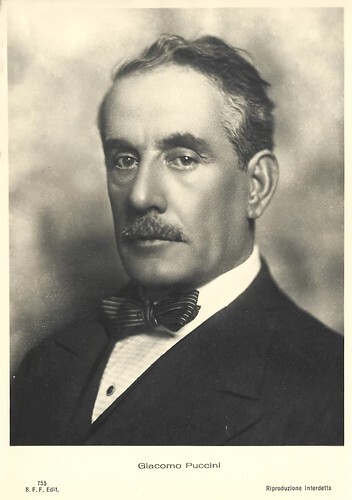
Italian postcard by B.F.F. Edit. (Casa Editrice Ballerini & Fratini, Firenze), no. 755. Giacomo Puccini (1858-1924) was an Italian opera composer, considered among the greatest, of the late 19th and early 20th centuries. He was a visionary and creator of the concepts that would govern cinema during the 20th century. His third opera, 'Manon Lescaut' (1893), was a success and brought him into contact with librettists Luigi Illica and Giuseppe Giacosa, who collaborated with him on his next three operas. The first of these, 'La bohème' (1896), is considered one of his best works and also one of the most romantic operas of all time. His next opera, 'Tosca' (1900), was Puccini's first foray into verismo, the naturalistic style in literature and opera. 'Madame Butterfly' (1904) was based on a play by David Belasco. This opera received a very hostile reception at its premiere. That criticism was largely orchestrated by rivals of Puccini. After several revisions, it became one of his most successful operas.
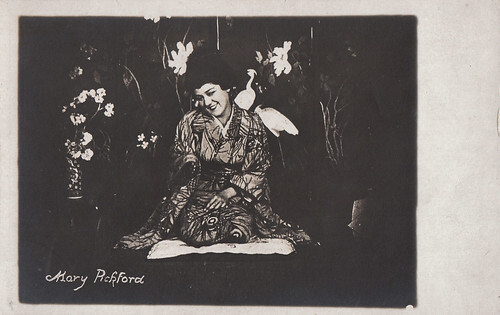
Vintage postcard. Mary Pickford as the Japanese character Cho-Cho-San in Madame Butterfly (Sidney Olcott, 1915). Collection: Marlene Pilaete.
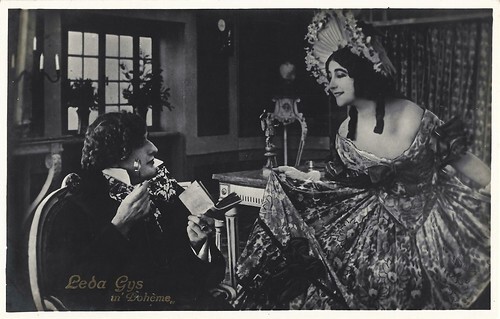
Italian postcard by G.B. Falci, Milano, no. 300. Photo: Leda Gys as Mimì in La Bohème (Amleto Palermi, 1917).
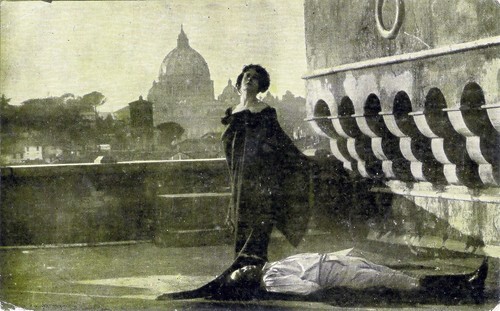
Spanish postcard by Amattler Marca Luna. Series 5, no. 18. Photo: Caesar Film. Francesca Bertini as Floria Tosca, Gustavo Serena as Mario Cavaradossi, and Alfredo De Antoni as Baron Scarpia in the Italian silent film Tosca (Alfredo De Antoni, 1918). The execution of Cavaradossi on the roof of the Castel Sant' Angelo, with St Peter's cupola in the distance. Tosca discovers Scarpia's betrayal. She has just stabbed Scarpia to death. When Scarpia's men try to arrest her, she jumps off the roof with the words: "O Scarpia, Avanti a Dio!"

Spanish postcard by Amattler Marca Luna chocolate, series 7, no. 18. Lyda Borelli in Carnevalesca (Amleto Palermi 1918), after Lucio d'Ambra. Photography was by Giovanni Grimaldi. Maria Teresa discovers she has killed the man she loved while he was innocent. Just as with the dead Scarpia in Puccini's opera 'Tosca' and the preceding play by Sardou performed by Sarah Bernhardt, candles are placed next to the dead person.
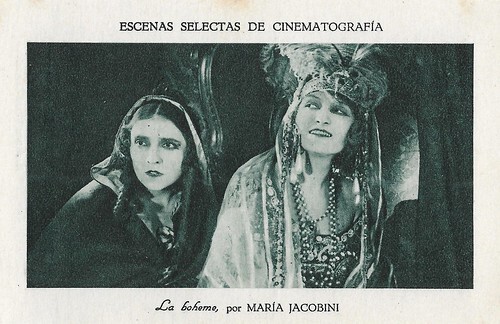
Spanish collector card in the Escenas selectas de cinematografia series. Maria Jacobini in La Bohème/ Boheme - Künstlerliebe (Gennaro Righelli, 1923), based on the novel by Henri Murger, which later was turned into an opera by Giacomo Puccini.

Italian postcard by Ballerini & Fratini, Firenze, no. 282. Photo: Metro-Goldwyn, Rome. Renée Adorée in La Boheme (King Vidor, 1926). Collection: Marlene Pilaete.
Puccini in the Italian silent film
If one consults the Internet Movie Database, it seems that in the silent era, only three Brazilian shorts of 1908-1909 were based on Giacomo Puccini’s operas. Many silent films were based on the sources for Puccini’s operas such as Victorien Sardou’s play 'Tosca' (1887). Another example (1887) is 'Scènes de la vie de bohème' (1849) by Henry Murger. And don't forget 'L’Histoire du chevalier des Grieux et de Manon Lescaut' (1731) by Abbé Prévost.
Puccini's 'Madame Butterfly' was based on a short story (1898) by John Luther Long, which was turned into a stage play (1900) by David Belasco, which in return inspired Puccini for his opera. Thus, to avoid any copyright problems, and being unable to recreate the voices and orchestras from the opera, filmmakers relied on the literary and theatrical sources for the operas, using their plots, but staging them with different means.
It may not come as a surprise that Italy produced several films based, directly or indirectly on Puccini’s operas, such as the 1918 version of Tosca with Francesca Bertini , which would be one of Bertini’s most popular films worldwide. Her regular co-star of the 1910s, Gustavo Serena , played Cavaradossi, while Alfredo De Antoni directed.
Exceptionally, Puccini’s music was played at the premiere of the film, with the consent of Giacomo Puccini’s musical agent Ricordi. Unfortunately, only a fragment of the film remains, but we do have a large card series. In the documentary, L’ultima diva/The Last Diva (1982) by Gianfranco Mingozzi, Bertini, in her nineties, re-enacts her dying scene at the end of Tosca, when her character commits suicide by jumping from the Castel Sant’Angelo.
Yet, this film version of 'Tosca' was preceded by a short version by André Calmettes, filmed in 1908 and starring Sarah Bernhardt , for whom Sardou had written the stage play. Also, in 1911 Dutch film director Theo Frenkel filmed in Great Britain a version of 'Tosca', in which the actress Lillian Russell debuted on screen. A reference to the death of Scarpia in 'Tosca' was made in Amleto Palermi’s film Carnevalesca (1918), starring Lyda Borelli as Queen Maria Teresa, who has unjustly stabbed her newlywed husband. Just as with the death of Scarpia in Puccini's opera 'Tosca' and the preceding play by Sardou as performed by Sarah Bernhardt , candles are placed next to the dead person.
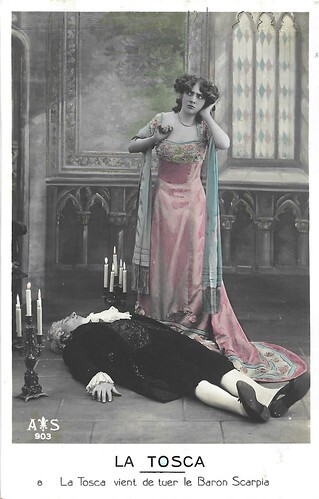
French postcard by A & S (Saint-Just), Paris, no. 903/8. Caption: Tosca has just killed Baron Scarpia. From a series of staging moments in the play by Sardou and the opera by Puccini. In the 1900s, publisher A.S./ Saint-Just made several staged, coloured postcard series based on operas and operettas such as 'Faust', 'Manon Lescaut', 'Carmen', 'Cavalleria rusticana', 'Die schöne Galathée' (presented as 'Galathée et Pygmalion'), 'La fille du régiment', 'Pippo et Bettina', 'La fille de Madame Angot' and 'Le passant'. There were also series based on books such as 'Paul et Virginie', and plays such as 'Cyrano de Bergerac' and 'Madame Sans-Gène'.
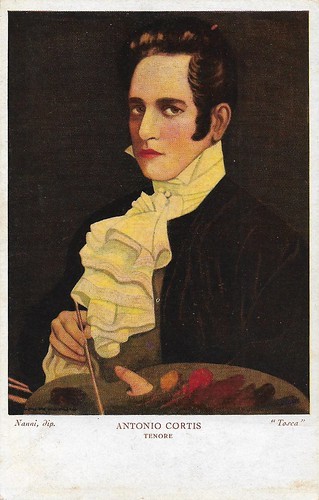
Italian postcard in the series La Voce del Padrone (HMV). Portrait: Nanni. Tenor Antonio Cortis as the painter Mario Cavaradossi in the opera 'Tosca' by Puccini. Hear him sing the famous aria' E lucevan le stelle' from Tosca here (recording of 1929) on YouTube.
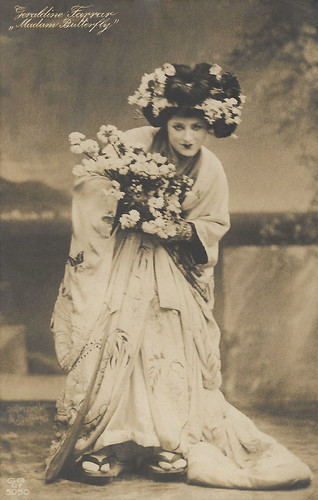
German postcard by GG Cie, no. 5050. Geraldine Farrar as Madame Butterfly.
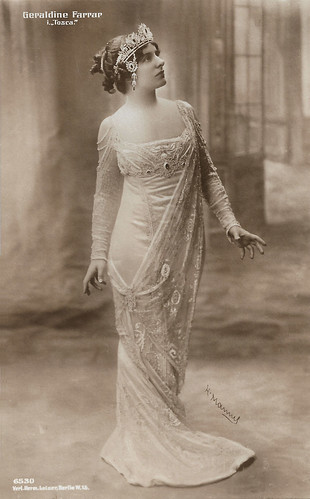
German postcard by Verlag Herm. Leiser, Berlin, no. 6530. Photo: H. Manuel. Geraldine Farrar in the opera 'Tosca'.
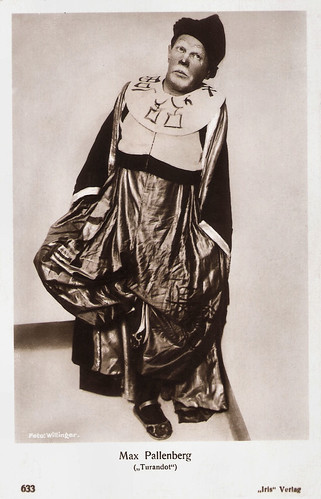
Austrian postcard by Iris Verlag, no. 633. Photo: Laszlo Willinger. Under the direction of Max Reinhardt, Max Pallenberg played Traffaldino in 'Turandot' (1926) by Giacomo Puccini at the Salzburger Festspiele.
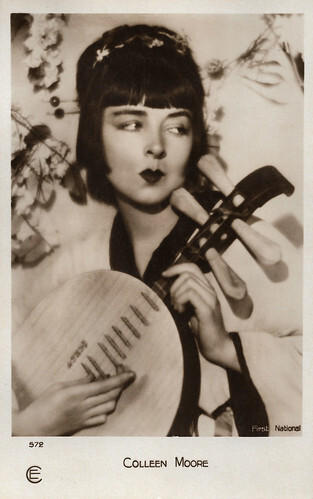
French postcard by Cinémagazine-Edition, no. 572. Photo: Freulich / First National. Colleen Moore as Madame Butterfly. The photo was specially posed for Motion Picture magazine in 1928.
Puccini in Hollywood
Hollywood also discovered Puccini as a source for silent films. In 1915, Mary Pickford starred opposite future film director Marshall Neilan as Lt. Pinkerton in Famous Players’ version of 'Madame Butterfly', directed by Sidney Olcott. The film was shot in a Chinese garden in Plainfield, New Jersey.
In Germany, Fritz Lang filmed a variation on the 'Madame Butterfly' plot as Harakiri (1919). While the film’s story has a preceding plot, halfway the film’s plot becomes the familiar one about a young Japanese woman abandoned by her lover, a European navy officer. She gives birth to their son in his absence and faithfully awaits his return. When he returns after four years, he is accompanied by his European wife. Lil Dagover played the lead.
Three major adaptations of 'La Bohème' were filmed in the silent era, in Italy, in Germany, and in the United States. Firstly, the Italian version was filmed in 1917 by Amleto Palermi, starring Leda Gys as Mimí and Luigi Serventi as Rodolphe.
In Germany, Italian director Gennaro Righelli, who had fled Italy after its film crisis in the early 1920s, directed Bohème a.k.a. Künstlerliebe (1923), starring Righelli’s lover Maria Jacobini as Mimí and Walter Janssen as Rodolphe. Serventi also joined, but now as Count Paul.
The most famous adaptation was the American film La Bohème (1926) by King Vidor , who gave the female lead to Lillian Gish and selected John Gilbert as Rodolphe. According to IMDb , John Gilbert was so infatuated with Gish that he would mess up his love scenes, so he could kiss her over and again. A review on IMDb indicates the strong emotional performance by Gish but also Vidor’s focus on her face as a strong asset of the film.
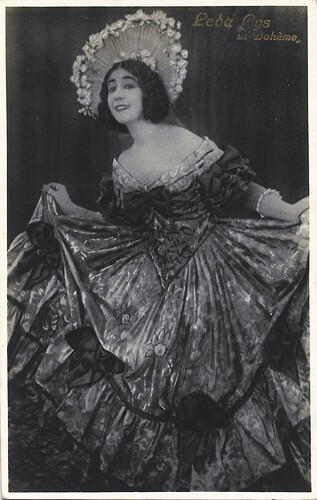
Italian postcard by G.B. Falci, Milano, no. 307. Leda Gys as Mimì in La Bohème (Amleto Palermi, 1917).

Italian postcard by Ed. Vettori, Bologna. Francesca Bertini als Tosca and Alfredo De Antoni as baron Scarpia in Tosca (Alfredo De Antoni, 1918).
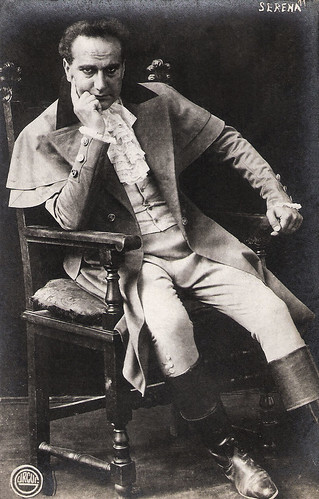
Spanish postcard by Gurgui, no. 11. Gustavo Serena as Mario Cavaradossi in Tosca (Alfredo De Antoni, 1918).
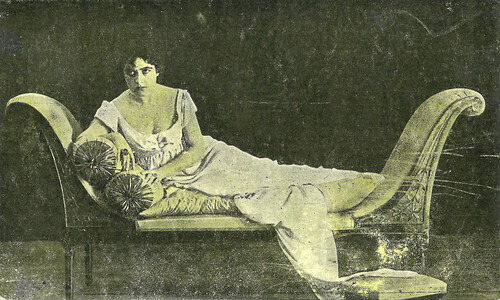
Spanish postcard by Amattler Marca Luna. Series 5, no. 1. Photo: Caesar Film. Francesca Bertini as Floria Tosca in Tosca (Alfredo De Antoni, 1918). Francesca Bertini as Tosca, in a citation of the famous portrait of Madame Récamier by J.L. David.
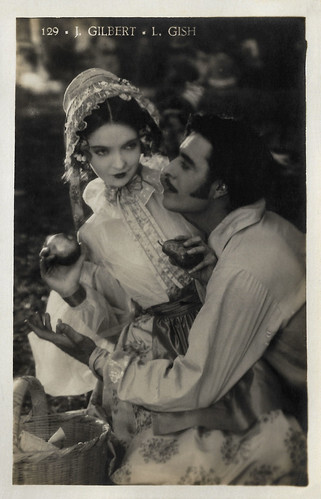
Italian postcard by Fotocelere, no. 129. Photo: Metro-Goldwyn-Mayer (MGM). Lillian Gish and John Gilbert in La Bohème (King Vidor, 1926). After 13 years with D.W. Griffith, Lillian Gish moved to MGM where her first picture was La Bohème (1926).
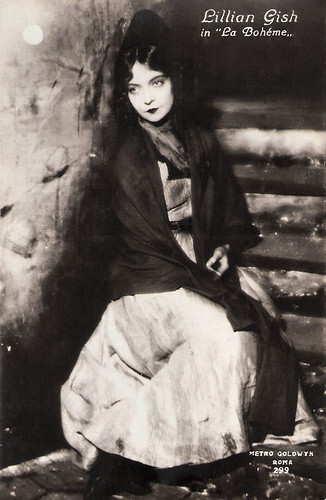
Italian postcard by Casa Editrice Ballerini & Fratini, Firenze (B.F.F.), no. 199. Photo: Metro-Goldwyn, Roma (MGM). Lillian Gish in (King Vidor, 1926).
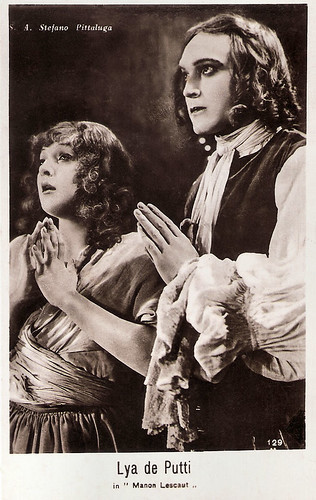
Italian postcard by G.B. Falci, Milano, no. 129. Photo: A. Stefano Pittaluga. Lya de Putti and Vladimir Gajdarov in Manon Lescaut (Arthur Robison, 1926), based on the oft-filmed novel by Abbe Prevost. It was produced and distributed by German film company Universum Film AG better known as Ufa. A young actress named Marlene Dietrich had a supporting role in this production and showed her later famous legs.
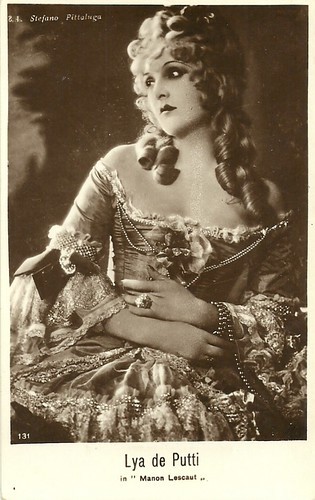
Italian postcard by G.B. Falci, Milano, no. 131. Photo: A. Stefano Pittaluga. Lya de Putti in Manon Lescaut (Arthur Robison, 1926).
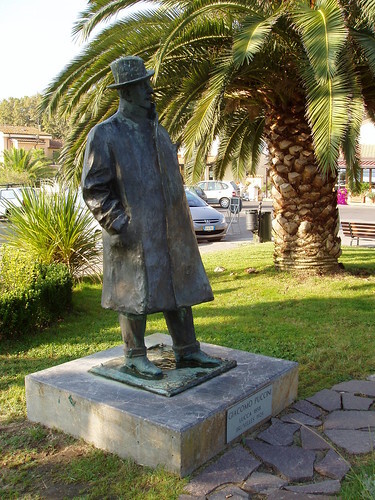
Torre del Lago, statue of Giacomo Puccini by Paul Troubetzkoy. Photo by Ivo Blom. Troubetzkoy's original statue (1925), quite small actually, can be viewed at the Museo Villa Puccini in Torre del Lago. From 1891, Puccini often spent time at Torre del Lago near Viareggio, where he built his Villa in 1900 and lived until 1921. An annual Puccini festival is now held at Torre del Lago, while his villa has become a museum.
Sources: Le Giornate del Cinema Muto (Italian), Jbill-74877 (IMDb), Wikipedia and .

Italian postcard by B.F.F. Edit. (Casa Editrice Ballerini & Fratini, Firenze), no. 755. Giacomo Puccini (1858-1924) was an Italian opera composer, considered among the greatest, of the late 19th and early 20th centuries. He was a visionary and creator of the concepts that would govern cinema during the 20th century. His third opera, 'Manon Lescaut' (1893), was a success and brought him into contact with librettists Luigi Illica and Giuseppe Giacosa, who collaborated with him on his next three operas. The first of these, 'La bohème' (1896), is considered one of his best works and also one of the most romantic operas of all time. His next opera, 'Tosca' (1900), was Puccini's first foray into verismo, the naturalistic style in literature and opera. 'Madame Butterfly' (1904) was based on a play by David Belasco. This opera received a very hostile reception at its premiere. That criticism was largely orchestrated by rivals of Puccini. After several revisions, it became one of his most successful operas.

Vintage postcard. Mary Pickford as the Japanese character Cho-Cho-San in Madame Butterfly (Sidney Olcott, 1915). Collection: Marlene Pilaete.

Italian postcard by G.B. Falci, Milano, no. 300. Photo: Leda Gys as Mimì in La Bohème (Amleto Palermi, 1917).

Spanish postcard by Amattler Marca Luna. Series 5, no. 18. Photo: Caesar Film. Francesca Bertini as Floria Tosca, Gustavo Serena as Mario Cavaradossi, and Alfredo De Antoni as Baron Scarpia in the Italian silent film Tosca (Alfredo De Antoni, 1918). The execution of Cavaradossi on the roof of the Castel Sant' Angelo, with St Peter's cupola in the distance. Tosca discovers Scarpia's betrayal. She has just stabbed Scarpia to death. When Scarpia's men try to arrest her, she jumps off the roof with the words: "O Scarpia, Avanti a Dio!"

Spanish postcard by Amattler Marca Luna chocolate, series 7, no. 18. Lyda Borelli in Carnevalesca (Amleto Palermi 1918), after Lucio d'Ambra. Photography was by Giovanni Grimaldi. Maria Teresa discovers she has killed the man she loved while he was innocent. Just as with the dead Scarpia in Puccini's opera 'Tosca' and the preceding play by Sardou performed by Sarah Bernhardt, candles are placed next to the dead person.

Spanish collector card in the Escenas selectas de cinematografia series. Maria Jacobini in La Bohème/ Boheme - Künstlerliebe (Gennaro Righelli, 1923), based on the novel by Henri Murger, which later was turned into an opera by Giacomo Puccini.

Italian postcard by Ballerini & Fratini, Firenze, no. 282. Photo: Metro-Goldwyn, Rome. Renée Adorée in La Boheme (King Vidor, 1926). Collection: Marlene Pilaete.
Puccini in the Italian silent film
If one consults the Internet Movie Database, it seems that in the silent era, only three Brazilian shorts of 1908-1909 were based on Giacomo Puccini’s operas. Many silent films were based on the sources for Puccini’s operas such as Victorien Sardou’s play 'Tosca' (1887). Another example (1887) is 'Scènes de la vie de bohème' (1849) by Henry Murger. And don't forget 'L’Histoire du chevalier des Grieux et de Manon Lescaut' (1731) by Abbé Prévost.
Puccini's 'Madame Butterfly' was based on a short story (1898) by John Luther Long, which was turned into a stage play (1900) by David Belasco, which in return inspired Puccini for his opera. Thus, to avoid any copyright problems, and being unable to recreate the voices and orchestras from the opera, filmmakers relied on the literary and theatrical sources for the operas, using their plots, but staging them with different means.
It may not come as a surprise that Italy produced several films based, directly or indirectly on Puccini’s operas, such as the 1918 version of Tosca with Francesca Bertini , which would be one of Bertini’s most popular films worldwide. Her regular co-star of the 1910s, Gustavo Serena , played Cavaradossi, while Alfredo De Antoni directed.
Exceptionally, Puccini’s music was played at the premiere of the film, with the consent of Giacomo Puccini’s musical agent Ricordi. Unfortunately, only a fragment of the film remains, but we do have a large card series. In the documentary, L’ultima diva/The Last Diva (1982) by Gianfranco Mingozzi, Bertini, in her nineties, re-enacts her dying scene at the end of Tosca, when her character commits suicide by jumping from the Castel Sant’Angelo.
Yet, this film version of 'Tosca' was preceded by a short version by André Calmettes, filmed in 1908 and starring Sarah Bernhardt , for whom Sardou had written the stage play. Also, in 1911 Dutch film director Theo Frenkel filmed in Great Britain a version of 'Tosca', in which the actress Lillian Russell debuted on screen. A reference to the death of Scarpia in 'Tosca' was made in Amleto Palermi’s film Carnevalesca (1918), starring Lyda Borelli as Queen Maria Teresa, who has unjustly stabbed her newlywed husband. Just as with the death of Scarpia in Puccini's opera 'Tosca' and the preceding play by Sardou as performed by Sarah Bernhardt , candles are placed next to the dead person.

French postcard by A & S (Saint-Just), Paris, no. 903/8. Caption: Tosca has just killed Baron Scarpia. From a series of staging moments in the play by Sardou and the opera by Puccini. In the 1900s, publisher A.S./ Saint-Just made several staged, coloured postcard series based on operas and operettas such as 'Faust', 'Manon Lescaut', 'Carmen', 'Cavalleria rusticana', 'Die schöne Galathée' (presented as 'Galathée et Pygmalion'), 'La fille du régiment', 'Pippo et Bettina', 'La fille de Madame Angot' and 'Le passant'. There were also series based on books such as 'Paul et Virginie', and plays such as 'Cyrano de Bergerac' and 'Madame Sans-Gène'.

Italian postcard in the series La Voce del Padrone (HMV). Portrait: Nanni. Tenor Antonio Cortis as the painter Mario Cavaradossi in the opera 'Tosca' by Puccini. Hear him sing the famous aria' E lucevan le stelle' from Tosca here (recording of 1929) on YouTube.

German postcard by GG Cie, no. 5050. Geraldine Farrar as Madame Butterfly.

German postcard by Verlag Herm. Leiser, Berlin, no. 6530. Photo: H. Manuel. Geraldine Farrar in the opera 'Tosca'.

Austrian postcard by Iris Verlag, no. 633. Photo: Laszlo Willinger. Under the direction of Max Reinhardt, Max Pallenberg played Traffaldino in 'Turandot' (1926) by Giacomo Puccini at the Salzburger Festspiele.

French postcard by Cinémagazine-Edition, no. 572. Photo: Freulich / First National. Colleen Moore as Madame Butterfly. The photo was specially posed for Motion Picture magazine in 1928.
Puccini in Hollywood
Hollywood also discovered Puccini as a source for silent films. In 1915, Mary Pickford starred opposite future film director Marshall Neilan as Lt. Pinkerton in Famous Players’ version of 'Madame Butterfly', directed by Sidney Olcott. The film was shot in a Chinese garden in Plainfield, New Jersey.
In Germany, Fritz Lang filmed a variation on the 'Madame Butterfly' plot as Harakiri (1919). While the film’s story has a preceding plot, halfway the film’s plot becomes the familiar one about a young Japanese woman abandoned by her lover, a European navy officer. She gives birth to their son in his absence and faithfully awaits his return. When he returns after four years, he is accompanied by his European wife. Lil Dagover played the lead.
Three major adaptations of 'La Bohème' were filmed in the silent era, in Italy, in Germany, and in the United States. Firstly, the Italian version was filmed in 1917 by Amleto Palermi, starring Leda Gys as Mimí and Luigi Serventi as Rodolphe.
In Germany, Italian director Gennaro Righelli, who had fled Italy after its film crisis in the early 1920s, directed Bohème a.k.a. Künstlerliebe (1923), starring Righelli’s lover Maria Jacobini as Mimí and Walter Janssen as Rodolphe. Serventi also joined, but now as Count Paul.
The most famous adaptation was the American film La Bohème (1926) by King Vidor , who gave the female lead to Lillian Gish and selected John Gilbert as Rodolphe. According to IMDb , John Gilbert was so infatuated with Gish that he would mess up his love scenes, so he could kiss her over and again. A review on IMDb indicates the strong emotional performance by Gish but also Vidor’s focus on her face as a strong asset of the film.

Italian postcard by G.B. Falci, Milano, no. 307. Leda Gys as Mimì in La Bohème (Amleto Palermi, 1917).

Italian postcard by Ed. Vettori, Bologna. Francesca Bertini als Tosca and Alfredo De Antoni as baron Scarpia in Tosca (Alfredo De Antoni, 1918).

Spanish postcard by Gurgui, no. 11. Gustavo Serena as Mario Cavaradossi in Tosca (Alfredo De Antoni, 1918).

Spanish postcard by Amattler Marca Luna. Series 5, no. 1. Photo: Caesar Film. Francesca Bertini as Floria Tosca in Tosca (Alfredo De Antoni, 1918). Francesca Bertini as Tosca, in a citation of the famous portrait of Madame Récamier by J.L. David.

Italian postcard by Fotocelere, no. 129. Photo: Metro-Goldwyn-Mayer (MGM). Lillian Gish and John Gilbert in La Bohème (King Vidor, 1926). After 13 years with D.W. Griffith, Lillian Gish moved to MGM where her first picture was La Bohème (1926).

Italian postcard by Casa Editrice Ballerini & Fratini, Firenze (B.F.F.), no. 199. Photo: Metro-Goldwyn, Roma (MGM). Lillian Gish in (King Vidor, 1926).

Italian postcard by G.B. Falci, Milano, no. 129. Photo: A. Stefano Pittaluga. Lya de Putti and Vladimir Gajdarov in Manon Lescaut (Arthur Robison, 1926), based on the oft-filmed novel by Abbe Prevost. It was produced and distributed by German film company Universum Film AG better known as Ufa. A young actress named Marlene Dietrich had a supporting role in this production and showed her later famous legs.

Italian postcard by G.B. Falci, Milano, no. 131. Photo: A. Stefano Pittaluga. Lya de Putti in Manon Lescaut (Arthur Robison, 1926).

Torre del Lago, statue of Giacomo Puccini by Paul Troubetzkoy. Photo by Ivo Blom. Troubetzkoy's original statue (1925), quite small actually, can be viewed at the Museo Villa Puccini in Torre del Lago. From 1891, Puccini often spent time at Torre del Lago near Viareggio, where he built his Villa in 1900 and lived until 1921. An annual Puccini festival is now held at Torre del Lago, while his villa has become a museum.
Sources: Le Giornate del Cinema Muto (Italian), Jbill-74877 (IMDb), Wikipedia and .
Published on October 11, 2024 22:00
October 10, 2024
The Winning of Barbara Worth (1926)
The final evening of the Giornate del Cinema Muto 2024 is for Henry King's wonderful Western The Winning of Barbara Worth (1926), starring Vilma Bánky, Ronald Colman and Gary Cooper in his first major role. The film owes part of its fame to Ned Mann's revolutionary visual effects in the climactic flood sequence. Mainly with miniature models, the scene depicts the 1905 formation of the Salton Sea. The spectacular effects will be the subject of the Jonathan Dennis Memorial Lecture by Craig Barron, Oscar winner in 2009 for the special effects of The Curious Case of Benjamin Button (David Fincher, 2008). The Winning of Barbara Worth will be accompanied by the Pordenone Chamber Orchestra conducted by Ben Palmer in the performance of the score that the festival commissioned from Neil Brand.
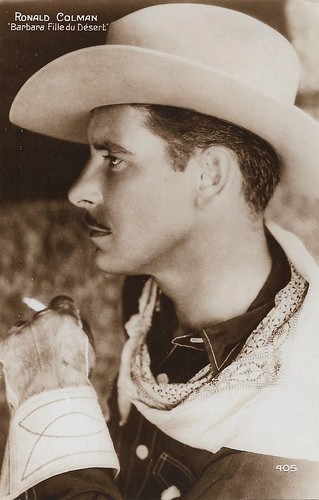
French postcard by Editions Cinémagazine, no. 405. Ronald Colman in The Winning of Barbara Worth (Henry King, 1926).
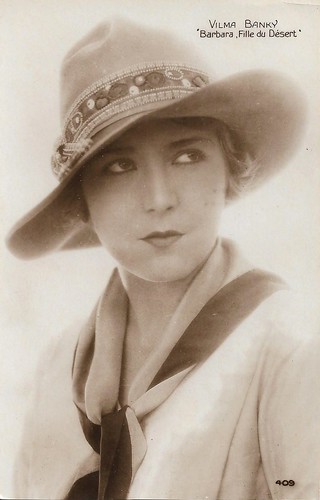
French postcard by Editions Cinémagazine, no. 409. Vilma Bánky in The Winning of Barbara Worth (Henry King, 1926).
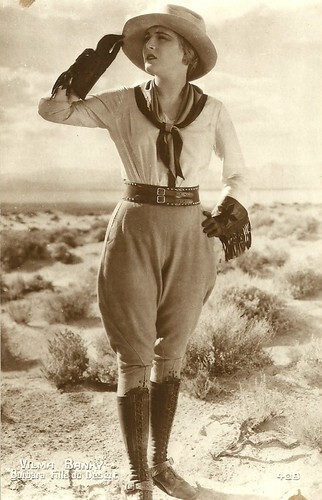
French postcard by Editions Cinémagazine, no. 428. Photo: Vilma Banky in The Winning of Barbara Worth (Henry King, 1926).
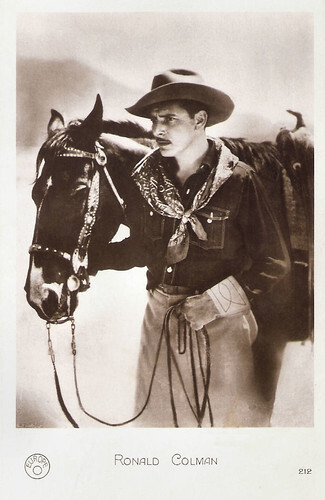
French postcard by Europe, no. 212. Ronald Colman in The Winning of Barbara Worth (Henry King, 1926).
A catastrophic flood
Frances Marion based her film script on the novel 'The Winning of Barbara Worth' by Harold Bell Wright, which in turn is a dramatisation of the real events that gave rise to the Salton Sea in California between 1905 and 1907. As a child, Barbara ( Vilma Bánky ) is orphaned when her settler parents perish trying to cross a California desert. She is rescued and adopted by Jefferson Worth (Charles Willis Lane). Worth's dream is to one day cultivate the desert with his own irrigation concept and thus take away its horrors.
Fifteen years later, Willard Holmes ( Ronald Colman ) arrives in the area. He is the West Coast chief engineer of his unscrupulous stepfather James Greenfield (E. J. Ratcliffe)'s company. Holmes plans to divert the Colorado River so that the desert will one day be greener. Worth joins forces with him. During his task, Willard meets the beautiful Barbara and the two fall in love.
However, Willarde has a rival: another, younger man is also vying for the favour of the beautiful Barbara. The lanky, grounded cowboy Abe Lee ( Gary Cooper ), the foreman of her father's ranch and company, shows interest in her. In the course of the story, Abe realises that Barbara's love for him will never be anything more than brotherly feelings.
.
James Greenfield, Willard Holmes's greedy employer, meanwhile, refuses to spend the money to reinforce his gigantic water project. The river is dammed, but the developer swindles the ranchers and refuses to reinforce the weakening dam, as he no longer needs it. An angry mob turns on Worth. After the project workers refuse to continue their work, an enormous flood puts everything under water and costs many lives. This catastrophic flood is the visual and dramatic highlight of the film. Willard, in unison with Abe Lee, heroically tries to save what can be saved. Barbara is impressed by his energy. He promises to return to marry her after he has conquered the Colorado River and turned the desert into a bountiful paradise.
The Winning of Barbara Worth (Henry King, 1926) was filmed in California's Imperial Valley and in the Black Rock Desert of Nevada. The reviewer of Variety in 1925: "Taking a story of this sort and injecting, besides the author’s purport, entertainment, is no child’s task. King has performed a miraculous task. The telling of the story, of course, was the big thing. Putting over the fine points of the yarn by showing a desert sandstorm and then showing the progress of reclamation work and the destruction done by faulty construction was a mountainous job, well executed."
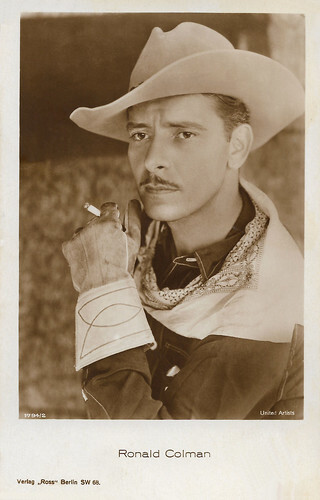
German postcard by Ross Verlag, no. 1794/2, 1927-1928. Photo: United Artists. Ronald Colman in The Winning of Barbara Worth (Henry King, 1926).
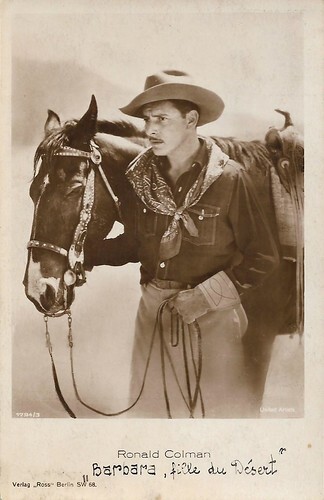
German postcard by Ross Verlag, no. 1794/3. Ronald Colman in The Winning of Barbara Worth (Henry King, 1926). On the card, the French title of the film is handwritten, Barbara, fille du Désert.
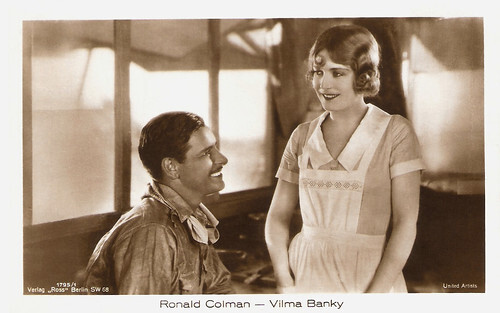
German postcard by Ross Verlag, no. 1795/1, 1927-1928. Photo: United Artists. Ronald Colman and Vilma Bánky in The Winning of Barbara Worth (Henry King, 1926).
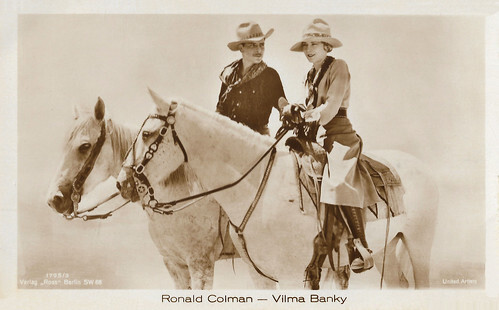
German postcard by Ross Verlag, no. 1795/3, 1927-1928. Photo: United Artists. Ronald Colman and Vilma Bánky in The Winning of Barbara Worth (Henry King, 1926).
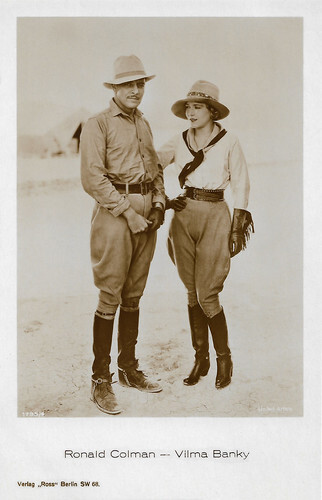
German postcard by Ross Verlag, no. 1795/4, 1927-1928. Photo: United Artists. Ronald Colman and Vilma Bánky in The Winning of Barbara Worth (Henry King, 1926).
Sources: the Giornate del Cinema Muto 2024 (Italian), Variety, Wikipedia (English, German and French) and IMDb

French postcard by Editions Cinémagazine, no. 405. Ronald Colman in The Winning of Barbara Worth (Henry King, 1926).

French postcard by Editions Cinémagazine, no. 409. Vilma Bánky in The Winning of Barbara Worth (Henry King, 1926).

French postcard by Editions Cinémagazine, no. 428. Photo: Vilma Banky in The Winning of Barbara Worth (Henry King, 1926).

French postcard by Europe, no. 212. Ronald Colman in The Winning of Barbara Worth (Henry King, 1926).
A catastrophic flood
Frances Marion based her film script on the novel 'The Winning of Barbara Worth' by Harold Bell Wright, which in turn is a dramatisation of the real events that gave rise to the Salton Sea in California between 1905 and 1907. As a child, Barbara ( Vilma Bánky ) is orphaned when her settler parents perish trying to cross a California desert. She is rescued and adopted by Jefferson Worth (Charles Willis Lane). Worth's dream is to one day cultivate the desert with his own irrigation concept and thus take away its horrors.
Fifteen years later, Willard Holmes ( Ronald Colman ) arrives in the area. He is the West Coast chief engineer of his unscrupulous stepfather James Greenfield (E. J. Ratcliffe)'s company. Holmes plans to divert the Colorado River so that the desert will one day be greener. Worth joins forces with him. During his task, Willard meets the beautiful Barbara and the two fall in love.
However, Willarde has a rival: another, younger man is also vying for the favour of the beautiful Barbara. The lanky, grounded cowboy Abe Lee ( Gary Cooper ), the foreman of her father's ranch and company, shows interest in her. In the course of the story, Abe realises that Barbara's love for him will never be anything more than brotherly feelings.
.
James Greenfield, Willard Holmes's greedy employer, meanwhile, refuses to spend the money to reinforce his gigantic water project. The river is dammed, but the developer swindles the ranchers and refuses to reinforce the weakening dam, as he no longer needs it. An angry mob turns on Worth. After the project workers refuse to continue their work, an enormous flood puts everything under water and costs many lives. This catastrophic flood is the visual and dramatic highlight of the film. Willard, in unison with Abe Lee, heroically tries to save what can be saved. Barbara is impressed by his energy. He promises to return to marry her after he has conquered the Colorado River and turned the desert into a bountiful paradise.
The Winning of Barbara Worth (Henry King, 1926) was filmed in California's Imperial Valley and in the Black Rock Desert of Nevada. The reviewer of Variety in 1925: "Taking a story of this sort and injecting, besides the author’s purport, entertainment, is no child’s task. King has performed a miraculous task. The telling of the story, of course, was the big thing. Putting over the fine points of the yarn by showing a desert sandstorm and then showing the progress of reclamation work and the destruction done by faulty construction was a mountainous job, well executed."

German postcard by Ross Verlag, no. 1794/2, 1927-1928. Photo: United Artists. Ronald Colman in The Winning of Barbara Worth (Henry King, 1926).

German postcard by Ross Verlag, no. 1794/3. Ronald Colman in The Winning of Barbara Worth (Henry King, 1926). On the card, the French title of the film is handwritten, Barbara, fille du Désert.

German postcard by Ross Verlag, no. 1795/1, 1927-1928. Photo: United Artists. Ronald Colman and Vilma Bánky in The Winning of Barbara Worth (Henry King, 1926).

German postcard by Ross Verlag, no. 1795/3, 1927-1928. Photo: United Artists. Ronald Colman and Vilma Bánky in The Winning of Barbara Worth (Henry King, 1926).

German postcard by Ross Verlag, no. 1795/4, 1927-1928. Photo: United Artists. Ronald Colman and Vilma Bánky in The Winning of Barbara Worth (Henry King, 1926).
Sources: the Giornate del Cinema Muto 2024 (Italian), Variety, Wikipedia (English, German and French) and IMDb
Published on October 10, 2024 22:00
October 9, 2024
Anna May Wong
Last year, Mattel created the new Barbie Anna May Wong inspired by the first Sino-American international star, to whom Le Giornate del Cinema Muto pays tribute with four films, two American and two shot in Germany. As with Louise Brooks, Wong's talent was enhanced more in Europe than in the United States. Anna May Wong (1905-1961) was the first Chinese American movie star, and the first Asian American actress to gain international recognition. Frustrated by the stereotypical supporting roles she reluctantly played in Hollywood. Wong left for Europe, where she starred in such classics as Piccadilly (1929).
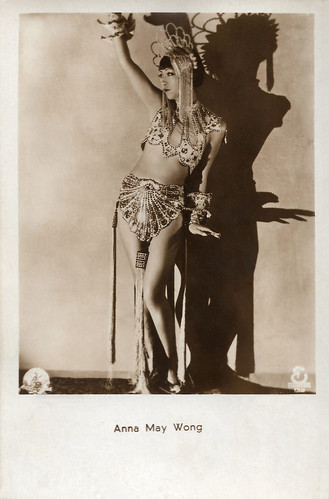
Austrian postcard by Iris-Verlag, no. 5853. Photo: British International Pictures (BIP). Anna May Wong in Piccadilly (Ewald André Dupont, 1929).

German postcard by Ross Verlag, no. 5028/2, 1930-1931. Photo: Atelier Manassé, Wien (Vienna).
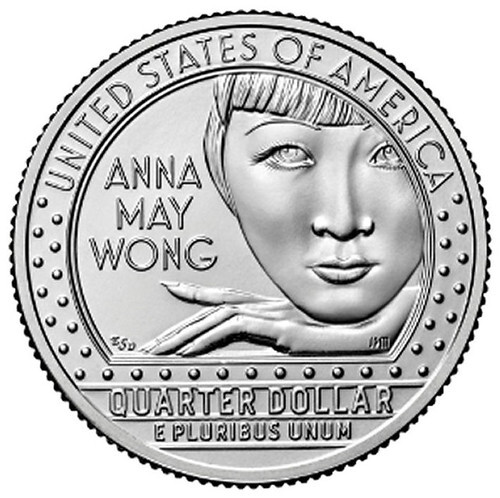
A U.S. coin featuring Anna May Wong, 2022.
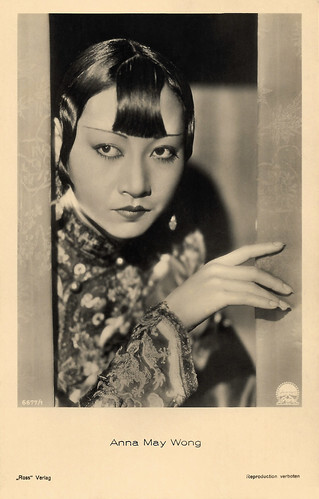
German postcard by Ross Verlag, no. 6677/1, 1931-1932. Photo: Paramount. Anna May Wong in Shanghai Express (Josef von Sternberg, 1932).

German postcard by Ross Verlag, no. 6679/1, 1931-1932. Photo: Paramount. Anna May Wong and Clive Brook in Shanghai Express (Josef von Sternberg, 1932).
Vibrant, erotic star quality
Anna May Wong (Chinese: 黃柳霜; pinyin: Huáng Liǔshuāng) was born Wong Liu Tsong (Frosted Yellow Willows) near the Chinatown neighbourhood of Los Angeles in 1905. She was the second of seven children born to Wong Sam Sing, owner of the Sam Kee Laundry in Los Angeles, and his second wife Lee Gon Toy. Wong had a passion for movies. By the age of 11, she had come up with her stage name Anna May Wong, formed by joining both her English and family names.
Wong was working at Hollywood's Ville de Paris department store when Metro Pictures needed 300 girl extras to appear in The Red Lantern (Albert Capellani, 1919) starring Nazimova as a Eurasian woman who falls in love with an American missionary. The film included scenes shot in Chinatown. Without her father's knowledge, a friend of his with movie connections helped Anna May land an uncredited role as an extra carrying a lantern. In 1921 she dropped out of Los Angeles High School to pursue a full-time acting career. Wong received her first screen credit for Bits of Life (Marshall Neilan, 1921), the first anthology film, in which she played the abused wife of Lon Chaney , playing a Chinaman.
At 17, she played her first leading part, Lotus Flower, in The Toll of the Sea (Chester M. Franklin, 1922), the first Technicolor production. The story by Hollywood's most famous scenarist at the time, Frances Marion, was loosely based on the opera Madame Butterfly but moved the action from Japan to China. Wong also played a concubine in Drifting (Tod Browning, 1923) and a scheming but eye-catching Mongol slave girl running around with Douglas Fairbanks Jr in the super-production The Thief of Bagdad (Raoul Walsh, 1924).
Richard Corliss in Time : “Wong is a luminous presence, fanning her arms in right-angle gestures that seem both Oriental and flapperish. Her best scenes are with Fairbanks, as they connive against each other and radiate contrasting and combined sexiness — a vibrant, erotic star quality.” Wong began cultivating a flapper image and became a fashion icon. In Peter Pan (Herbert Brenon, 1924), shot by her cousin cinematographer James Wong Howe, she played Princess Tiger Lily who shares a long kiss with Betty Bronson as Peter. Peter Pan was the hit of the Christmas season. She appeared again with Lon Chaney in Mr. Wu (William Nigh, 1927) at MGM and with Warner Oland and Dolores Costello in Old San Francisco (Alan Crosland, 1927) at Warner Brothers.
Wong starred in The Silk Bouquet/The Dragon Horse (Harry Revier, 1927), one of the first US films to be produced with Chinese backing, provided by San Francisco's Chinese Six Companies. The story was set in China during the Ming Dynasty and featured Asian actors playing Asian roles. Hollywood studios didn't know what to do with Wong. Her ethnicity prevented US filmmakers from seeing her as a leading lady. Frustrated by the stereotypical supporting roles as the naïve and self-sacrificing ‘Butterfly’ and the evil ‘Dragon Lady’, Anna May Wong left for Europe in 1928.
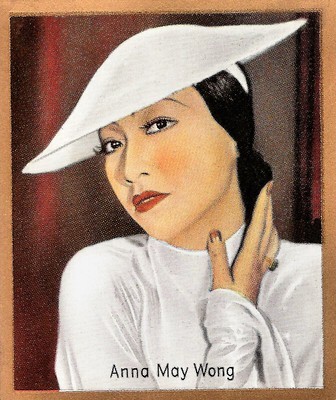
German cigarette card in the series Unsere Bunten Filmbilder by Ross Verlag for Cigarettenfabrik Josetti, Berlin, no. 187. Photo: Paramount.
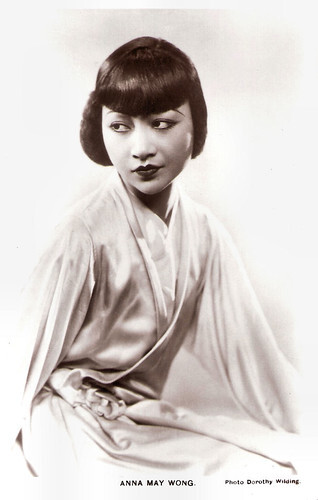
British postcard in the Picturegoer series. Photo: Dorothy Wilding.
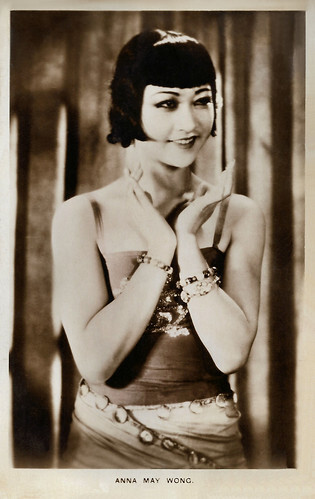
British postcard in the Colourgraph Series, London, no. C 7.
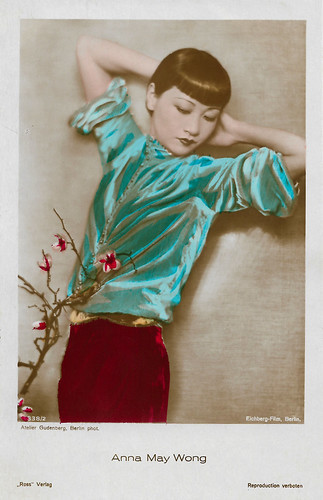
German postcard by Ross Verlag, no. 4338/2, 1929-1930. Photo: Atelier Gudenberg, Berlin / Eichberg-Film, Berlin. Collection: Geoffrey Donaldson Institute.
A Sensation In Europe
In Germany, Anna May Wong became a sensation in Schmutziges Geld/Show Life (Richard Eichberg, 1928) with Heinrich George . The New York Times reported that Wong was "acclaimed not only as an actress of transcendent talent but as a great beauty (...) Berlin critics, who were unanimous in praise of both the star and the production, neglect to mention that Anna May is of American birth. They mention only her Chinese origins."
Other film parts were a circus artist on the run from a murder charge in Großstadtschmetterling/City Butterfly (Richard Eichberg, 1929), and a dancer in pre-Revolutionary Russia in Hai-Tang (Richard Eichberg, Jean Kemm, 1930). In Vienna, she played the title role in the stage operetta 'Tschun Tschi' in fluent German. Wong became an inseparable friend of director Leni Riefenstahl . According to Wikipedia , her close friendships with several women throughout her life, including Marlene Dietrich , led to rumours of lesbianism which damaged her public reputation.
London producer Basil Dean bought the play 'A Circle of Chalk' for Wong to appear in with the young Laurence Olivier , her first stage performance in the UK. Her final silent film, Piccadilly (Ewald André Dupont, 1929), caused a sensation in the UK. Gilda Gray was the top-billed actress, but Variety commented that Wong "outshines the star", and that "from the moment Miss Wong dances in the kitchen's rear, she steals Piccadilly from Miss Gray."
It would be the first of five English films in which she had a starring role, including her first sound film The Flame of Love (Richard Eichberg, Walter Summers, 1930). American studios were looking for fresh European talent. Ironically, Wong caught their eye and she was offered a contract with Paramount Studios in 1930.
She was featured in Daughter of the Dragon (Lloyd Corrigan, 1931) as the vengeful daughter of Fu Manchu (Warner Oland), and with Marlene Dietrich in Shanghai Express (Josef von Sternberg, 1932). Wong spent the first half of the 1930s travelling between the United States and Europe for film and stage work. She repeatedly turned to the stage and cabaret for a creative outlet. On Broadway, she starred in the drama 'On the Spot', which ran for 167 performances and which she would later film as Dangerous to Know (Robert Florey, 1938).
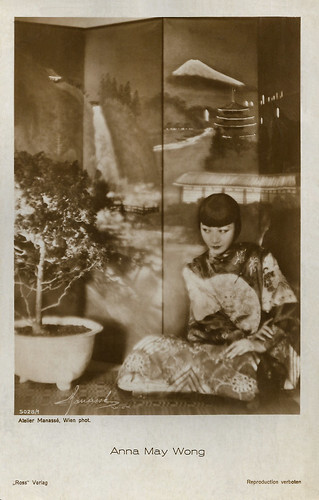
German postcard by Ross Verlag, no. 5028/1, 1930-1931. Photo: Manassé, Wien.
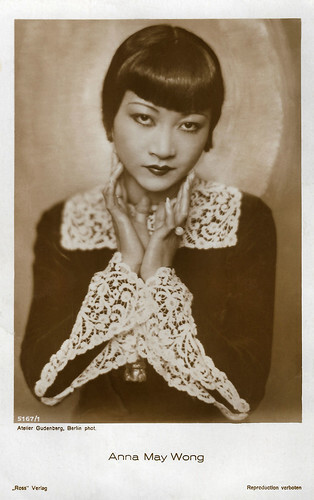
German postcard by Ross Verlag, no. 5167/1, 1930-1931. Photo: Atelier Gudenberg, Berlin.

German postcard by Ross Verlag, no. 5477/1, 1930-1931. Photo: Atelier Manassé, Wien (Vienna).
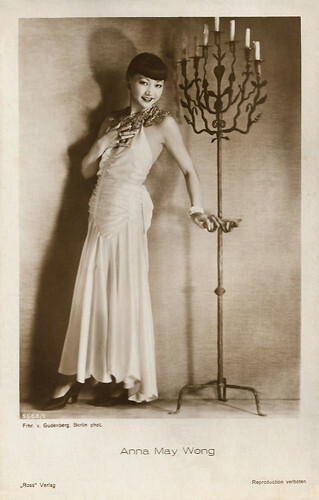
German postcard by Ross Verlag, no. 5568/1, 1930-1931. Photo: Frhr. v. Gudenberg, Berlin.
Too Chinese to play a Chinese
Anna May Wong became more outspoken in her advocacy for Chinese American causes and for better film roles. Because of the Hays Code's anti-miscegenation rules, she was passed over for the leading female role in The Son-Daughter (Clarence Brown, 1932) in favour of Helen Hayes. Metro-Goldwyn-Mayer deemed her ‘too Chinese to play a Chinese’ in the film, and the Hays Office would not have allowed her to perform romantic scenes since the film's male lead, Ramón Novarro , was not Asian.
Wong was scheduled to play the role of a mistress to a corrupt Chinese general in The Bitter Tea of General Yen (Frank Capra, 1933), but the role went instead to Toshia Mori. Her British film Java Head (Thorold Dickinson, J. Walter Ruben, 1934) was the only film in which Wong kissed the lead male character, her white husband in the film.
In 1935 she was dealt the most severe disappointment of her career when Metro-Goldwyn-Mayer refused to consider her for the leading role of the Chinese character O-Lan in the film version of Pearl S. Buck's The Good Earth (Sidney Franklin, 1937). Paul Muni , an actor of European descent, was to play O-lan's husband, Wang Lung, and MGM chose German actress Luise Rainer for the leading role. Rainer won the Best Actress Oscar for her performance.
Wong spent the next year touring China, visiting her father and her younger brothers and sister in her family's ancestral village Taishan and studying Chinese culture. To complete her contract with Paramount Pictures, she starred in several B movies, including Daughter of Shanghai (Robert Florey, 1937), Dangerous to Know (Robert Florey, 1938), and King of Chinatown (Nick Grinde, 1939) with Akim Tamiroff. These smaller-budgeted films could be bolder than the higher-profile releases, and Wong used this to her advantage to portray successful, professional, Chinese-American characters.
Wong's cabaret act, which included songs in Cantonese, French, English, German, Danish, Swedish, and other languages, took her from the US to Europe and Australia through the 1930s and 1940s. She paid less attention to her film career during World War II but devoted her time and money to helping the Chinese cause against Japan. Wong starred in Lady from Chungking (William Nigh, 1942) and Bombs over Burma (Joseph H. Lewis, 1943), both anti-Japanese propaganda made by the poverty row studio Producers Releasing Corporation. She donated her salary for both films to United China Relief. She invested in real estate and owned several properties in Hollywood.
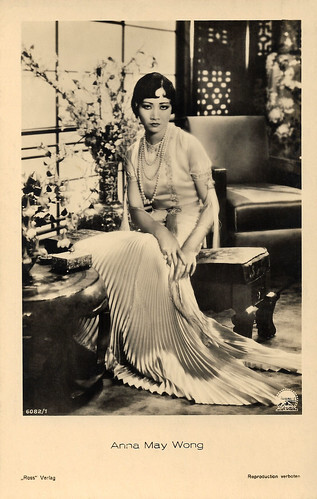
German postcard by Ross Verlag, no. 6082/1, 1931-1932. Photo: Paramount. Anna May Wong in Daughter of the Dragon (Lloyd Corrigan, 1931).
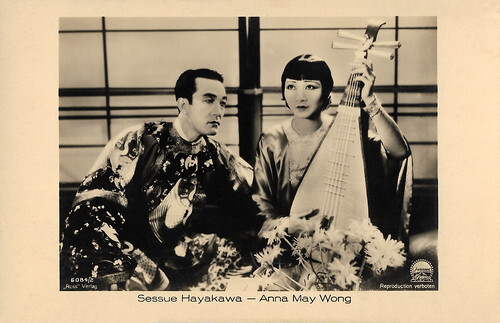
German postcard by Ross Verlag, no. 6084/2, 1931-1932. Photo: Paramount. Sessue Hayakawa and Anna May Wong in Daughter of the Dragon (Lloyd Corrigan, 1931).
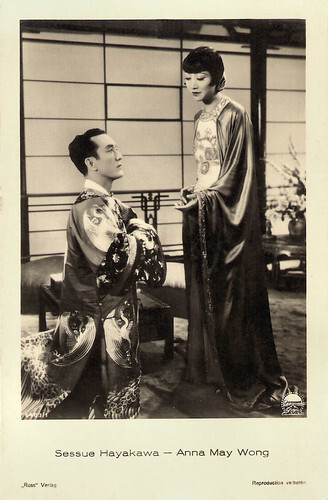
German postcard by Ross Verlag, no. 6403/1, 1931-1932. Photo: Paramount. Sessue Hayakawa and Anna May Wong in Daughter of the Dragon (Lloyd Corrigan, 1931).

German postcard by Ross Verlag, no. 6887/1, 1931-1932. Photo: Paramount.
Rumoured Mistress Of Several Prominent Film Men
Anna May Wong returned to the public eye in the 1950s in several television appearances as well as her own detective series The Gallery of Madame Liu-Tsong (1951-1952), the first US television show starring an Asian-American series lead. After the completion of the series, Wong's health began to deteriorate. In late 1953 she suffered an internal haemorrhage, which her brother attributed to the onset of menopause, her continued heavy drinking, and financial worries.
In the following years, she did guest spots on television series. In 1960, she returned to film playing housekeeper to Lana Turner in the thriller Portrait in Black (Michael Gordon, 1960). She was scheduled to play the role of Madame Liang in the film production of Rodgers and Hammerstein's Flower Drum Song (Henry Koster, 1961) when she died of a heart attack at home in Santa Monica in 1961.
Anna May Wong was 56. For decades after her death, Wong was remembered principally for the stereotypical sly ‘Dragon Lady’ and demure ‘Butterfly’ roles that she was often given. Anna May Wong never married, but over the years, she was the rumoured mistress of several prominent film men: Marshall Neilan (14 years older, supposedly Wong's lover when she was 15), director Tod Browning (23 years older, when she was 16) and Charles Rosher ( Mary Pickford 's favourite cinematographer, who was nearly 20 years older, when Wong was 20). But no biographer can say for sure that any of these affairs occurred.
Matthew Sweet in The Guardian : “And this is the trouble with Anna May Wong. We disapprove of the stereotypes she fleshed out - the treacherous, tragic daughters of the dragon - but her performances still seduce, for the same reason they did in the 1920s and 30s.” Her life and career were re-evaluated by three new biographies, a meticulous filmography, and a British documentary about her life, called Frosted Yellow Willows.
Wikipedia : “Through her films, public appearances and prominent magazine features, she helped to ‘humanize’ Asian Americans to white audiences during a period of overt racism and discrimination. Asian Americans, especially the Chinese, had been viewed as perpetually foreign in U.S. society but Wong's films and public image established her as an Asian-American citizen at a time when laws discriminated against Asian immigration and citizenship.”
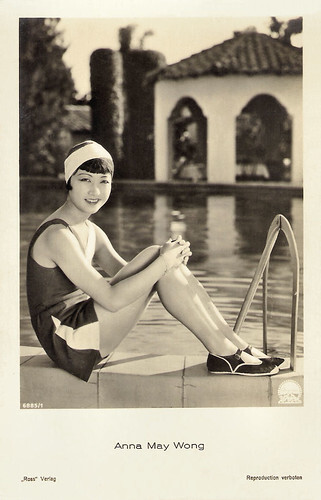
German postcard by Ross Verlag, no. 6885/1, 1931-1932. Photo: Paramount.
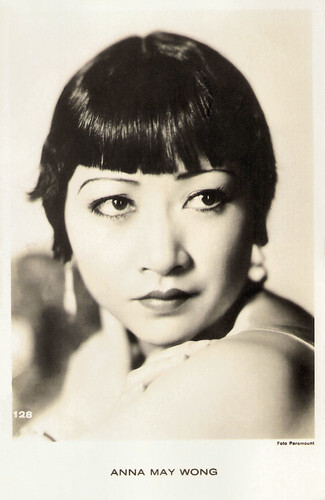
Dutch postcard, no. 128. Photo: Paramount. Sent by mail in 1932.
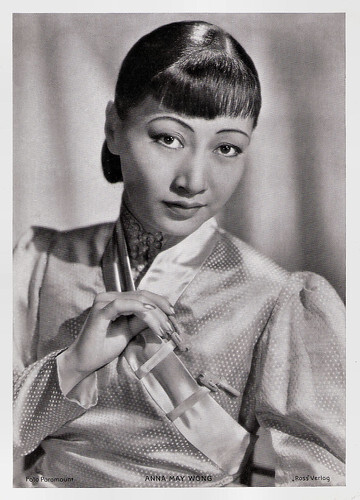
German postcard by Ross Verlag. Photo: Paramount.
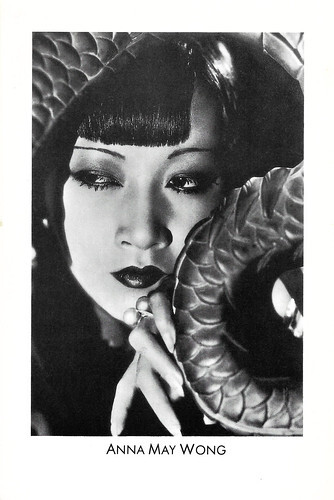
British postcard by James Gardiner Postcards, Watford in The Glamour Queens series, no. 15, 1988. Photo: Otto Dyar.
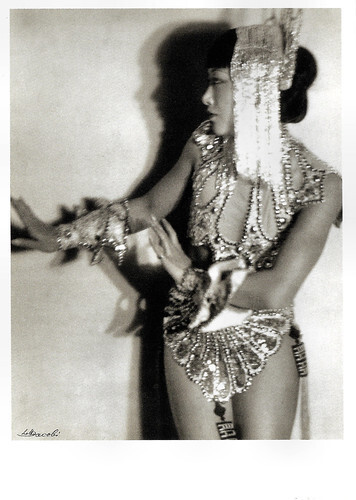
German postcard in the Ausdrucktstanz series by Galerie Bodo Niemann, Berlin, no. 08/10. Photo: Lotte Jacobi. Caption: Anna May Wong, Berlin, ca. 1931.
Anna May Wong in a clip of Piccadilly (1929). Source: BFI (YouTube).
Marlene Dietrich and Anna May Wong in a cheeky scene from Shanghai Express (1932). Source: JD Stirling (YouTube).
Sources: Le Giornate del Cinema Muto (Italian), Richard Corliss (Time), Matthew Sweet (The Guardian), (IMDb), Wikipedia and .

Austrian postcard by Iris-Verlag, no. 5853. Photo: British International Pictures (BIP). Anna May Wong in Piccadilly (Ewald André Dupont, 1929).

German postcard by Ross Verlag, no. 5028/2, 1930-1931. Photo: Atelier Manassé, Wien (Vienna).

A U.S. coin featuring Anna May Wong, 2022.

German postcard by Ross Verlag, no. 6677/1, 1931-1932. Photo: Paramount. Anna May Wong in Shanghai Express (Josef von Sternberg, 1932).

German postcard by Ross Verlag, no. 6679/1, 1931-1932. Photo: Paramount. Anna May Wong and Clive Brook in Shanghai Express (Josef von Sternberg, 1932).
Vibrant, erotic star quality
Anna May Wong (Chinese: 黃柳霜; pinyin: Huáng Liǔshuāng) was born Wong Liu Tsong (Frosted Yellow Willows) near the Chinatown neighbourhood of Los Angeles in 1905. She was the second of seven children born to Wong Sam Sing, owner of the Sam Kee Laundry in Los Angeles, and his second wife Lee Gon Toy. Wong had a passion for movies. By the age of 11, she had come up with her stage name Anna May Wong, formed by joining both her English and family names.
Wong was working at Hollywood's Ville de Paris department store when Metro Pictures needed 300 girl extras to appear in The Red Lantern (Albert Capellani, 1919) starring Nazimova as a Eurasian woman who falls in love with an American missionary. The film included scenes shot in Chinatown. Without her father's knowledge, a friend of his with movie connections helped Anna May land an uncredited role as an extra carrying a lantern. In 1921 she dropped out of Los Angeles High School to pursue a full-time acting career. Wong received her first screen credit for Bits of Life (Marshall Neilan, 1921), the first anthology film, in which she played the abused wife of Lon Chaney , playing a Chinaman.
At 17, she played her first leading part, Lotus Flower, in The Toll of the Sea (Chester M. Franklin, 1922), the first Technicolor production. The story by Hollywood's most famous scenarist at the time, Frances Marion, was loosely based on the opera Madame Butterfly but moved the action from Japan to China. Wong also played a concubine in Drifting (Tod Browning, 1923) and a scheming but eye-catching Mongol slave girl running around with Douglas Fairbanks Jr in the super-production The Thief of Bagdad (Raoul Walsh, 1924).
Richard Corliss in Time : “Wong is a luminous presence, fanning her arms in right-angle gestures that seem both Oriental and flapperish. Her best scenes are with Fairbanks, as they connive against each other and radiate contrasting and combined sexiness — a vibrant, erotic star quality.” Wong began cultivating a flapper image and became a fashion icon. In Peter Pan (Herbert Brenon, 1924), shot by her cousin cinematographer James Wong Howe, she played Princess Tiger Lily who shares a long kiss with Betty Bronson as Peter. Peter Pan was the hit of the Christmas season. She appeared again with Lon Chaney in Mr. Wu (William Nigh, 1927) at MGM and with Warner Oland and Dolores Costello in Old San Francisco (Alan Crosland, 1927) at Warner Brothers.
Wong starred in The Silk Bouquet/The Dragon Horse (Harry Revier, 1927), one of the first US films to be produced with Chinese backing, provided by San Francisco's Chinese Six Companies. The story was set in China during the Ming Dynasty and featured Asian actors playing Asian roles. Hollywood studios didn't know what to do with Wong. Her ethnicity prevented US filmmakers from seeing her as a leading lady. Frustrated by the stereotypical supporting roles as the naïve and self-sacrificing ‘Butterfly’ and the evil ‘Dragon Lady’, Anna May Wong left for Europe in 1928.

German cigarette card in the series Unsere Bunten Filmbilder by Ross Verlag for Cigarettenfabrik Josetti, Berlin, no. 187. Photo: Paramount.

British postcard in the Picturegoer series. Photo: Dorothy Wilding.

British postcard in the Colourgraph Series, London, no. C 7.

German postcard by Ross Verlag, no. 4338/2, 1929-1930. Photo: Atelier Gudenberg, Berlin / Eichberg-Film, Berlin. Collection: Geoffrey Donaldson Institute.
A Sensation In Europe
In Germany, Anna May Wong became a sensation in Schmutziges Geld/Show Life (Richard Eichberg, 1928) with Heinrich George . The New York Times reported that Wong was "acclaimed not only as an actress of transcendent talent but as a great beauty (...) Berlin critics, who were unanimous in praise of both the star and the production, neglect to mention that Anna May is of American birth. They mention only her Chinese origins."
Other film parts were a circus artist on the run from a murder charge in Großstadtschmetterling/City Butterfly (Richard Eichberg, 1929), and a dancer in pre-Revolutionary Russia in Hai-Tang (Richard Eichberg, Jean Kemm, 1930). In Vienna, she played the title role in the stage operetta 'Tschun Tschi' in fluent German. Wong became an inseparable friend of director Leni Riefenstahl . According to Wikipedia , her close friendships with several women throughout her life, including Marlene Dietrich , led to rumours of lesbianism which damaged her public reputation.
London producer Basil Dean bought the play 'A Circle of Chalk' for Wong to appear in with the young Laurence Olivier , her first stage performance in the UK. Her final silent film, Piccadilly (Ewald André Dupont, 1929), caused a sensation in the UK. Gilda Gray was the top-billed actress, but Variety commented that Wong "outshines the star", and that "from the moment Miss Wong dances in the kitchen's rear, she steals Piccadilly from Miss Gray."
It would be the first of five English films in which she had a starring role, including her first sound film The Flame of Love (Richard Eichberg, Walter Summers, 1930). American studios were looking for fresh European talent. Ironically, Wong caught their eye and she was offered a contract with Paramount Studios in 1930.
She was featured in Daughter of the Dragon (Lloyd Corrigan, 1931) as the vengeful daughter of Fu Manchu (Warner Oland), and with Marlene Dietrich in Shanghai Express (Josef von Sternberg, 1932). Wong spent the first half of the 1930s travelling between the United States and Europe for film and stage work. She repeatedly turned to the stage and cabaret for a creative outlet. On Broadway, she starred in the drama 'On the Spot', which ran for 167 performances and which she would later film as Dangerous to Know (Robert Florey, 1938).

German postcard by Ross Verlag, no. 5028/1, 1930-1931. Photo: Manassé, Wien.

German postcard by Ross Verlag, no. 5167/1, 1930-1931. Photo: Atelier Gudenberg, Berlin.

German postcard by Ross Verlag, no. 5477/1, 1930-1931. Photo: Atelier Manassé, Wien (Vienna).

German postcard by Ross Verlag, no. 5568/1, 1930-1931. Photo: Frhr. v. Gudenberg, Berlin.
Too Chinese to play a Chinese
Anna May Wong became more outspoken in her advocacy for Chinese American causes and for better film roles. Because of the Hays Code's anti-miscegenation rules, she was passed over for the leading female role in The Son-Daughter (Clarence Brown, 1932) in favour of Helen Hayes. Metro-Goldwyn-Mayer deemed her ‘too Chinese to play a Chinese’ in the film, and the Hays Office would not have allowed her to perform romantic scenes since the film's male lead, Ramón Novarro , was not Asian.
Wong was scheduled to play the role of a mistress to a corrupt Chinese general in The Bitter Tea of General Yen (Frank Capra, 1933), but the role went instead to Toshia Mori. Her British film Java Head (Thorold Dickinson, J. Walter Ruben, 1934) was the only film in which Wong kissed the lead male character, her white husband in the film.
In 1935 she was dealt the most severe disappointment of her career when Metro-Goldwyn-Mayer refused to consider her for the leading role of the Chinese character O-Lan in the film version of Pearl S. Buck's The Good Earth (Sidney Franklin, 1937). Paul Muni , an actor of European descent, was to play O-lan's husband, Wang Lung, and MGM chose German actress Luise Rainer for the leading role. Rainer won the Best Actress Oscar for her performance.
Wong spent the next year touring China, visiting her father and her younger brothers and sister in her family's ancestral village Taishan and studying Chinese culture. To complete her contract with Paramount Pictures, she starred in several B movies, including Daughter of Shanghai (Robert Florey, 1937), Dangerous to Know (Robert Florey, 1938), and King of Chinatown (Nick Grinde, 1939) with Akim Tamiroff. These smaller-budgeted films could be bolder than the higher-profile releases, and Wong used this to her advantage to portray successful, professional, Chinese-American characters.
Wong's cabaret act, which included songs in Cantonese, French, English, German, Danish, Swedish, and other languages, took her from the US to Europe and Australia through the 1930s and 1940s. She paid less attention to her film career during World War II but devoted her time and money to helping the Chinese cause against Japan. Wong starred in Lady from Chungking (William Nigh, 1942) and Bombs over Burma (Joseph H. Lewis, 1943), both anti-Japanese propaganda made by the poverty row studio Producers Releasing Corporation. She donated her salary for both films to United China Relief. She invested in real estate and owned several properties in Hollywood.

German postcard by Ross Verlag, no. 6082/1, 1931-1932. Photo: Paramount. Anna May Wong in Daughter of the Dragon (Lloyd Corrigan, 1931).

German postcard by Ross Verlag, no. 6084/2, 1931-1932. Photo: Paramount. Sessue Hayakawa and Anna May Wong in Daughter of the Dragon (Lloyd Corrigan, 1931).

German postcard by Ross Verlag, no. 6403/1, 1931-1932. Photo: Paramount. Sessue Hayakawa and Anna May Wong in Daughter of the Dragon (Lloyd Corrigan, 1931).

German postcard by Ross Verlag, no. 6887/1, 1931-1932. Photo: Paramount.
Rumoured Mistress Of Several Prominent Film Men
Anna May Wong returned to the public eye in the 1950s in several television appearances as well as her own detective series The Gallery of Madame Liu-Tsong (1951-1952), the first US television show starring an Asian-American series lead. After the completion of the series, Wong's health began to deteriorate. In late 1953 she suffered an internal haemorrhage, which her brother attributed to the onset of menopause, her continued heavy drinking, and financial worries.
In the following years, she did guest spots on television series. In 1960, she returned to film playing housekeeper to Lana Turner in the thriller Portrait in Black (Michael Gordon, 1960). She was scheduled to play the role of Madame Liang in the film production of Rodgers and Hammerstein's Flower Drum Song (Henry Koster, 1961) when she died of a heart attack at home in Santa Monica in 1961.
Anna May Wong was 56. For decades after her death, Wong was remembered principally for the stereotypical sly ‘Dragon Lady’ and demure ‘Butterfly’ roles that she was often given. Anna May Wong never married, but over the years, she was the rumoured mistress of several prominent film men: Marshall Neilan (14 years older, supposedly Wong's lover when she was 15), director Tod Browning (23 years older, when she was 16) and Charles Rosher ( Mary Pickford 's favourite cinematographer, who was nearly 20 years older, when Wong was 20). But no biographer can say for sure that any of these affairs occurred.
Matthew Sweet in The Guardian : “And this is the trouble with Anna May Wong. We disapprove of the stereotypes she fleshed out - the treacherous, tragic daughters of the dragon - but her performances still seduce, for the same reason they did in the 1920s and 30s.” Her life and career were re-evaluated by three new biographies, a meticulous filmography, and a British documentary about her life, called Frosted Yellow Willows.
Wikipedia : “Through her films, public appearances and prominent magazine features, she helped to ‘humanize’ Asian Americans to white audiences during a period of overt racism and discrimination. Asian Americans, especially the Chinese, had been viewed as perpetually foreign in U.S. society but Wong's films and public image established her as an Asian-American citizen at a time when laws discriminated against Asian immigration and citizenship.”

German postcard by Ross Verlag, no. 6885/1, 1931-1932. Photo: Paramount.

Dutch postcard, no. 128. Photo: Paramount. Sent by mail in 1932.

German postcard by Ross Verlag. Photo: Paramount.

British postcard by James Gardiner Postcards, Watford in The Glamour Queens series, no. 15, 1988. Photo: Otto Dyar.

German postcard in the Ausdrucktstanz series by Galerie Bodo Niemann, Berlin, no. 08/10. Photo: Lotte Jacobi. Caption: Anna May Wong, Berlin, ca. 1931.
Anna May Wong in a clip of Piccadilly (1929). Source: BFI (YouTube).
Marlene Dietrich and Anna May Wong in a cheeky scene from Shanghai Express (1932). Source: JD Stirling (YouTube).
Sources: Le Giornate del Cinema Muto (Italian), Richard Corliss (Time), Matthew Sweet (The Guardian), (IMDb), Wikipedia and .
Published on October 09, 2024 22:00
October 8, 2024
France Dhélia
Among the 200 feature films and shorts from international archives presented at le Giornate del Cinema Muto, there are always three special events with an orchestra. Between the opening and closing film, there's also the mid-week screening. Tonight the French film La sultane de l'amour/The Sultaness of Love (Charles Burguet, René Le Somptier, 1919) will be presented at the Teatro Verdi. It is the exotic tale of the tormented loves of Princess Daoulah and Prince Mourad, who had met, she disguised as a girl of the people, he as a poor fisherman, and who could not find each other. France Dhélia (1894-1964) plays the title figure, Princess Daoulah. The French actress performed in many silent films by Gaston Roudès. One of her other well-known roles was the Queen of Sheba in the biblical film Le berceau de dieu/The Cradle of God (1926).
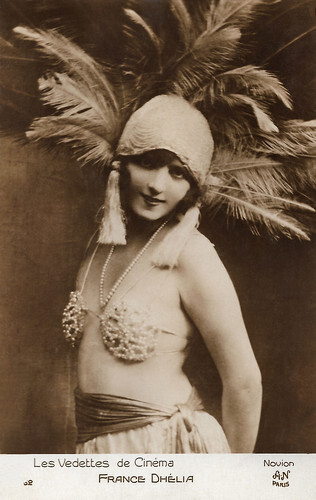
French postcard in the Les Vedettes de Cinéma series by A.N., Paris, no. 62. Photo: Novion.
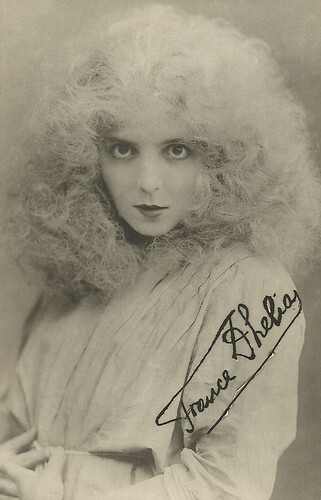
French postcard. Collection: Didier Hanson.
The sultaness of love
France Dhélia was born Franceline Benoit in 1894, in a village near Blois, thus raised in the area of the famous French royal castles along the Loire River.
She made her film début under the name of Mado Floréal in L’Ambitieuse (Camille de Morlhon, 1912) with Gabriel Signoret . Afterwards, she played in various comedies with the character Fred, directed by René Hervil, who also played Fred himself.
During the First World War, she took the name of France Dhélia. She made her first film with director René Le Somptier and appeared in her first feature-length film: L’instinct est maitre/The Instinct is the Ruler (Jacques Feyder, 1917).
She rose to stardom when she played Sultane Daoulah in La sultane d’amour/The Sultaness of Love (René Le Somptier, Charles Burguet, 1918). It was the first film shot at the new Victorine studios in Nice. The film had sets designed by Marco de Gastyne.
This film was followed by Malencontre/Inopportune (Germaine Dulac, 1920), La montée vers l’Acropole/The Climb to the Acropolis (René Le Somptier, 1920), Le coeur magnifique/The Magnificent Heart (Séverin-Mars, Jean Legrand, 1921), La bête traquée/The Trapped Beast (René Le Somptier, Michel Carré, 1922) with Edmond Van Daële, the comedy Petite hôtel à louer/Little Hotel for Rent (Pierre Colombier, 1923) with Gaston Modot , the title role in La garçonne/The Flapper (Armand du Plessy, 1923), and Néné (Jacques de Baroncelli, 1924).
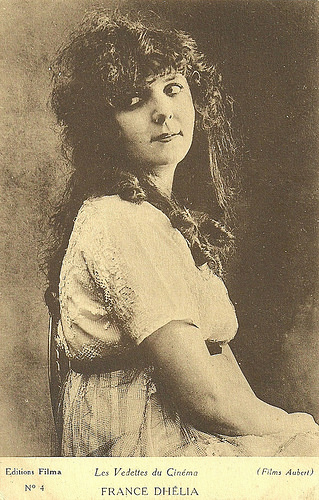
French postcard in the series Les Vedettes du Cinéma by Editions Filma, no. 4. Photo: Films Aubert.
The Queen of Sheba
Between 1923 and 1925, France Dhélia performed in many films by Gaston Roudès, her favourite director.
These films included La guitare et le jazz band/The Guitar and the Jazz band (1923), L’ombre du bonheur (1924) with Constant Rémy , Pulcinella (1925), La maternelle/The Nursery School (1925) with Lucien Dalsace , Le chemin de la gloire/The Road of Glory (1926), Cousine de France/Cousin of France (1927) with Jean-Louis Allibert, and La maison au soleil/House in the Sun (1928).
In those years, Dhélia was often paired with actor Lucien Dalsace , as in La maternelle, Oiseaux de passage and Les petits. Around 1925 she was at the peak of her success. When sound film set in, Dhélia continued to play mostly in films by Roudès, though she did not always play the lead.
An exception was the part of the Queen of Sheba in the biblical film Le berceau de dieu/The Cradle of God (Fred LeRoy Granville, 1926). Other exceptions were the main female character, Blanche, in Jean Epstein’s late silent crime drama Sa tête/Her Head (1929), and a minor part in the early sound film Méphisto (Henri Delbain, Georges Vinter, 1930) opposite a young Jean Gabin .
Her sound films include Le gamin de Paris/Paris Urchin (1932) with Alice Tissot, Roger la Honte (1933) with Constant Rémy , Flofloche (1934), and Le chante de l’amour/The Song of Love (1935). Her last film was Une main a frappé/A Hand Hit (1939). At age 45, France Dhélia quit cinema, and a quarter of a century later she died quietly in Paris in 1964.
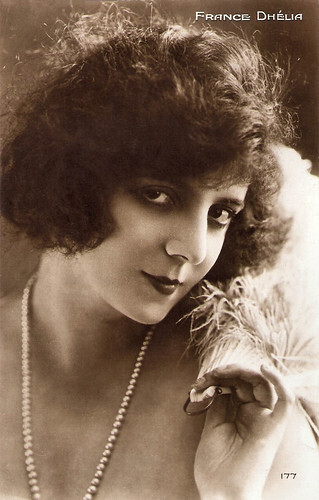
French postcard by Cinémagazine-Edition, Paris, no. 177.
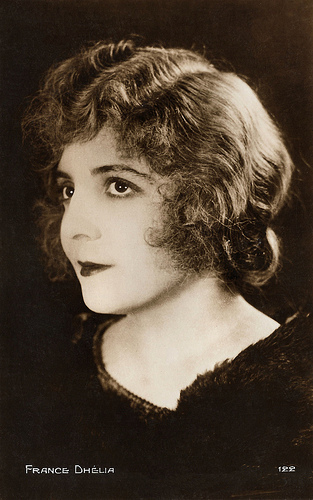
French postcard by Cinémagazine, no. 122.
Sources: Caroline Hanotte (CineArtistes), Wikipedia (French) and .
This post was last updated on 4 January 2024.

French postcard in the Les Vedettes de Cinéma series by A.N., Paris, no. 62. Photo: Novion.

French postcard. Collection: Didier Hanson.
The sultaness of love
France Dhélia was born Franceline Benoit in 1894, in a village near Blois, thus raised in the area of the famous French royal castles along the Loire River.
She made her film début under the name of Mado Floréal in L’Ambitieuse (Camille de Morlhon, 1912) with Gabriel Signoret . Afterwards, she played in various comedies with the character Fred, directed by René Hervil, who also played Fred himself.
During the First World War, she took the name of France Dhélia. She made her first film with director René Le Somptier and appeared in her first feature-length film: L’instinct est maitre/The Instinct is the Ruler (Jacques Feyder, 1917).
She rose to stardom when she played Sultane Daoulah in La sultane d’amour/The Sultaness of Love (René Le Somptier, Charles Burguet, 1918). It was the first film shot at the new Victorine studios in Nice. The film had sets designed by Marco de Gastyne.
This film was followed by Malencontre/Inopportune (Germaine Dulac, 1920), La montée vers l’Acropole/The Climb to the Acropolis (René Le Somptier, 1920), Le coeur magnifique/The Magnificent Heart (Séverin-Mars, Jean Legrand, 1921), La bête traquée/The Trapped Beast (René Le Somptier, Michel Carré, 1922) with Edmond Van Daële, the comedy Petite hôtel à louer/Little Hotel for Rent (Pierre Colombier, 1923) with Gaston Modot , the title role in La garçonne/The Flapper (Armand du Plessy, 1923), and Néné (Jacques de Baroncelli, 1924).

French postcard in the series Les Vedettes du Cinéma by Editions Filma, no. 4. Photo: Films Aubert.
The Queen of Sheba
Between 1923 and 1925, France Dhélia performed in many films by Gaston Roudès, her favourite director.
These films included La guitare et le jazz band/The Guitar and the Jazz band (1923), L’ombre du bonheur (1924) with Constant Rémy , Pulcinella (1925), La maternelle/The Nursery School (1925) with Lucien Dalsace , Le chemin de la gloire/The Road of Glory (1926), Cousine de France/Cousin of France (1927) with Jean-Louis Allibert, and La maison au soleil/House in the Sun (1928).
In those years, Dhélia was often paired with actor Lucien Dalsace , as in La maternelle, Oiseaux de passage and Les petits. Around 1925 she was at the peak of her success. When sound film set in, Dhélia continued to play mostly in films by Roudès, though she did not always play the lead.
An exception was the part of the Queen of Sheba in the biblical film Le berceau de dieu/The Cradle of God (Fred LeRoy Granville, 1926). Other exceptions were the main female character, Blanche, in Jean Epstein’s late silent crime drama Sa tête/Her Head (1929), and a minor part in the early sound film Méphisto (Henri Delbain, Georges Vinter, 1930) opposite a young Jean Gabin .
Her sound films include Le gamin de Paris/Paris Urchin (1932) with Alice Tissot, Roger la Honte (1933) with Constant Rémy , Flofloche (1934), and Le chante de l’amour/The Song of Love (1935). Her last film was Une main a frappé/A Hand Hit (1939). At age 45, France Dhélia quit cinema, and a quarter of a century later she died quietly in Paris in 1964.

French postcard by Cinémagazine-Edition, Paris, no. 177.

French postcard by Cinémagazine, no. 122.
Sources: Caroline Hanotte (CineArtistes), Wikipedia (French) and .
This post was last updated on 4 January 2024.
Published on October 08, 2024 22:00
October 7, 2024
Silent actors from Latin America
At le Giornate del Cinema Muto 2024 in Pordenone, one of the major retrospectives is dedicated to Latin America. The curator of this festival section, Paolo Tosini, has put together a programme of 31 titles. It aims to be an impulse for research and the preservation of silent material in Latin America, involving 16 archives from 10 different countries: Argentina, Brazil, Chile, Colombia, Cuba, Ecuador, Mexico, Peru, Paraguay and Uruguay. Most of the silent films of these countries are little known outside Latin America. For the occasion, EFSP selected 12 film stars born in Latin America.
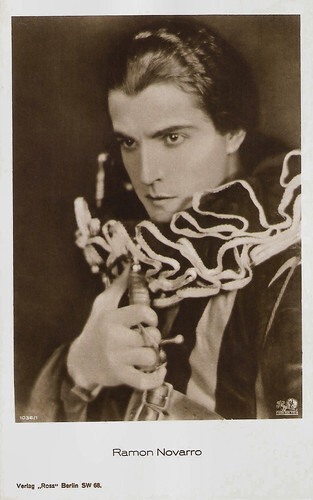
German postcard by Ross Verlag, Berlin, no. 1036/1, 1927-1928. Photo: Phoebus Film. Ramon Novarro in Scaramouche (Rex Ingram, 1923).
Mexican-American actor Ramon Novarro (1899-1968) was a popular Latin Lover of the 1920s and early 1930s. He was the star of silent Hollywood's biggest epic, Ben-Hur (Fred Niblo, 1925).
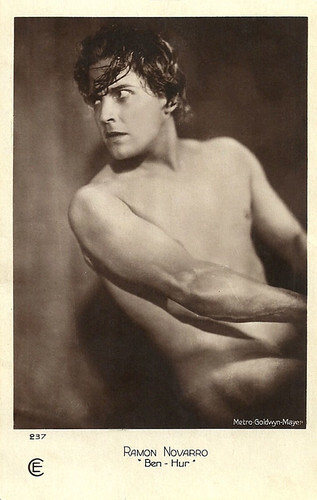
French postcard by Editions Cinemagazine, no. 237. Photo: Metro-Goldwyn-Mayer. Ramon Novarro in Ben Hur: A Tale of the Christ (Fred Niblo, 1925).
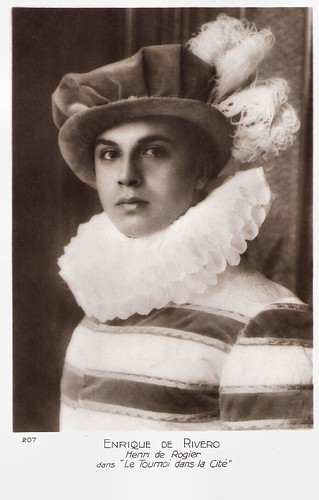
French postcard by Cinémagazine-Edition, no. 207. Photo: Enrique (de) Rivero as Henri de Rogier in Le tournoi dans la cité/The Tournament (Jean Renoir, 1928), with . The film was scripted by Henry Dupuis-Mazuel. Sets by Robert Mallet-Stevens, costumes by George Barbier and exteriors shot at Carcassonne.
Enrique Rivero aka Riveros (1906-1954) was a Chilean actor, who peaked in the late 1920s and early 1930s French cinema. He is famous for his lead in Jean Cocteau's Le sang d'un poète/The Blood of a Poet (1930).
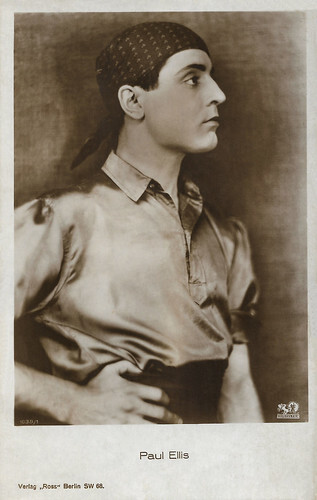
German postcard by Ross Verlag, no. 1035/1, 1927-1928. Photo: Phoebus-Film, Berlin. Paul Ellis in The Bandolero (Tom Terriss, 1924).
Manuel Granada (1896-1974) was an Argentine actor who appeared in American, Spanish, Argentine and Mexican films. He made his film debut in the Metro-Goldwyn film The Bandolero in 1924 under the name Manuel Granado, but would soon become better known as Paul Ellis in films such as Three Hours (1927) and The Bridge of San Luis Rey (1929). Indeed, our card already uses the name of Paul Ellis for his first Hollywood film. Ellis would have a long career but mostly as a supporting actor. In the early 1930s, he was in Spanish language versions of Hollywood productions, while after the war he acted in Argentine in various films. All in all, he acted in over 110 films.
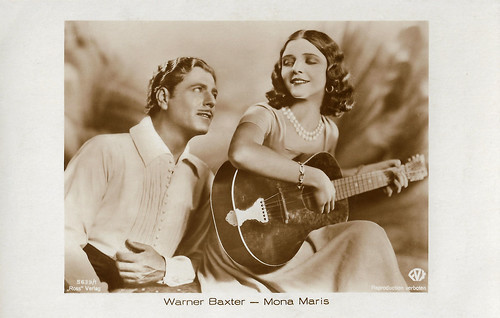
German postcard by Ross Verlag, Berlin, no. 5639/1, 1930-1931. Photo: Fox. Warner Baxter and Mona Maris in Romance of the Rio Grande (Alfred Santell, 1929).
Sultry, sleepy-eyed Argentine brunette Mona Maris (1903-1991) appeared in both European and Hollywood silent films. After the arrival of sound, she starred in a string of Spanish-language versions of American films.
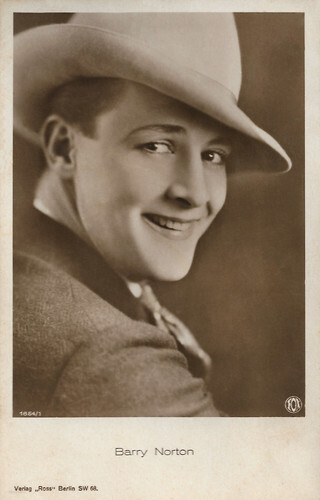
German postcard by Ross Verlag, no. 1854/1, 1927-1928. Photo: Fox.
Barry Norton (1905-1956) was a boyishly handsome Argentine-born actor, who had a career in the United States. In Hollywood, he acted in over 90 films by F.W. Murnau and others. He started in silent films in 1925 and is perhaps best known for his role as Juan Harker in Universal Pictures' Spanish-language version of Drácula (1931). The English-language role of Jonathan Harker was originated by David Manners.
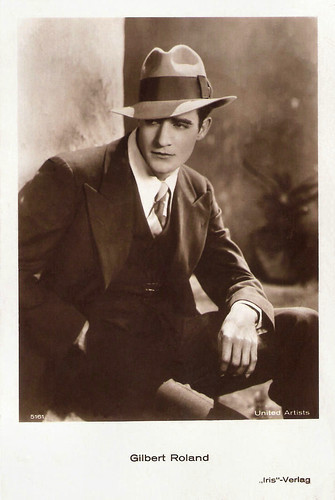
Austrian postcard by Iris-Verlag, no. 5161. Photo: United Artists.
Mexican-born American film star Gilbert Roland (1905–1994) was often cast in the typical 'Latin Lover' role during the silent era. Roland later played romantic lead roles in Spanish language adaptations of American films. In the mid-1940s, he was featured in the popular film series The Cisco Kid. Beginning in the 1940s, critics began to take notice of his acting and he was praised for his supporting roles in John Huston's We Were Strangers (1949), The Bad and the Beautiful (1952), and Cheyenne Autumn (1964). His last film appearance was in the Western Barbarosa (1984).
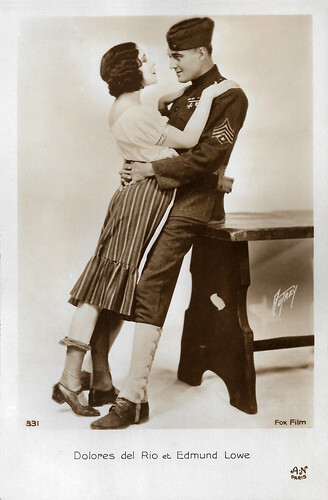
French postcard by A.N., Paris, no. 331. Photo: Max Munn Autrey / Fox Film. Dolores Del Rio and Edmund Lowe in What Price Glory? (Raoul Walsh, 1926).
Mexican and American actress Dolores del Río (1905–1983) was a Hollywood star in the 1920s and 1930s. She was also one of the most important female actresses of the Golden Age of Mexican cinema in the 1940s and 1950s. Del Río was the first major Latin cross-over star in Hollywood and was considered one of the most beautiful faces that have emerged in Hollywood cinema. She also appeared in several European films.
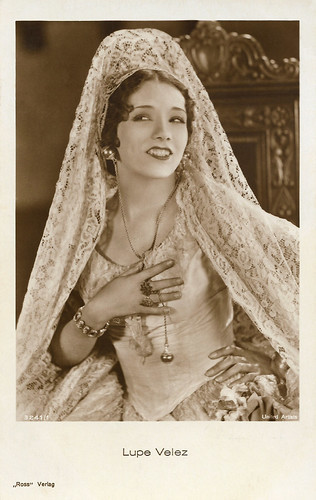
German postcard by Ross Verlag, no. 3241/1, 1928-1929. Photo: United Artists. Lupe Velez in The Gaucho (F. Richard Jones, 1927).
Lupe Velez (1908-1944) was one of the first Mexican actresses to succeed in Hollywood. Her nicknames were 'The Mexican Spitfire' and 'Hot Pepper'. She was the leading lady in such silent films as The Gaucho (1927), Lady of the Pavements (1928), and Wolf Song (1929). During the 1930s, her well-known explosive screen persona was exploited in a series of successful films like Hot Pepper (1933), Strictly Dynamite (1934), and Hollywood Party (1934). In the 1940s, Vélez's popularity peaked after appearing in the Mexican Spitfire films, a series created to capitalise on Vélez's well-documented fiery personality. She had several highly publicised romances and a stormy marriage. In 1944, Vélez died of an intentional overdose of the barbiturate drug Seconal. Her death and the circumstances surrounding it have been the subject of speculation and controversy.
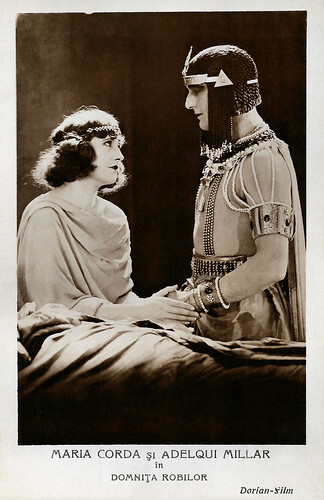
Romanian postcard. Photo: Dorian-Film. Maria Corda and Adelqui Migliar in Die Sklavenkönigin/The Moon of Israel (Mihaly Kertesz aka Michael Curtiz, 1924).
Adelqui Migliar aka Adelqui Millar (1891-1956) was a Chilean actor who was the male star of Dutch silent cinema in the 1910s and early 1920s. Later on, he acted and directed in Britain, Austria and Argentina.
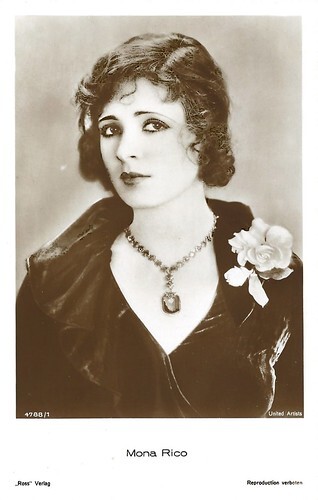
German postcard by Ross Verlag, no. 4768/1, 1929-1930. Photo: United Artists.
Mona Rico (1907-1994) was a Mexican American actress. Ernst Lubitsch discovered Rico in 1928 and gave her the lead of the female antagonist in the United Artists silent drama Eternal Love (1929), starring John Barrymore and Camilla Horn, and set in the Swiss Alps in the early 19th century.
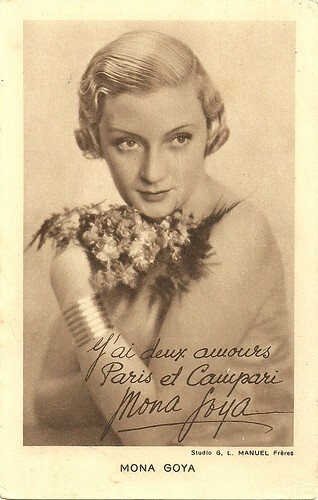
French postcard for Campari. Photo: Studio G.L. Manuel Frères.
Mona Goya (1909–1961) was a Mexican-born French film actress who probably debuted in film in Germaine Dulac's late silent film Princesse Mandane (1928). In the same year, she also acted in various other films, such as the period piece Madame Recamier (1928) by Gaston Ravel and she had a small part in Marcel L'Herbier's lavish production L'Argent (1928). Goya's career really set off with the arrival of sound film around 1930.
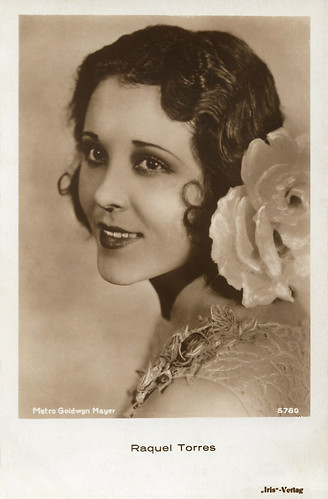
Austrian postcard by Iris Verlag, no. 5780. Photo: Metro-Goldwyn-Mayer.
Raquel Torres (1908-1987) was a Mexican-born American film actress. She had her breakthrough as a Polynesian beauty in White Shadows in the South Seas (1928). She played island girls, and biracial beauties and was a sexy foil to the Marx Brothers in Duck Soup (1933). After marrying a stockbroker in 1935, she retired.
Source: Le Giornate del Cinema Muto (Italian).

German postcard by Ross Verlag, Berlin, no. 1036/1, 1927-1928. Photo: Phoebus Film. Ramon Novarro in Scaramouche (Rex Ingram, 1923).
Mexican-American actor Ramon Novarro (1899-1968) was a popular Latin Lover of the 1920s and early 1930s. He was the star of silent Hollywood's biggest epic, Ben-Hur (Fred Niblo, 1925).

French postcard by Editions Cinemagazine, no. 237. Photo: Metro-Goldwyn-Mayer. Ramon Novarro in Ben Hur: A Tale of the Christ (Fred Niblo, 1925).

French postcard by Cinémagazine-Edition, no. 207. Photo: Enrique (de) Rivero as Henri de Rogier in Le tournoi dans la cité/The Tournament (Jean Renoir, 1928), with . The film was scripted by Henry Dupuis-Mazuel. Sets by Robert Mallet-Stevens, costumes by George Barbier and exteriors shot at Carcassonne.
Enrique Rivero aka Riveros (1906-1954) was a Chilean actor, who peaked in the late 1920s and early 1930s French cinema. He is famous for his lead in Jean Cocteau's Le sang d'un poète/The Blood of a Poet (1930).

German postcard by Ross Verlag, no. 1035/1, 1927-1928. Photo: Phoebus-Film, Berlin. Paul Ellis in The Bandolero (Tom Terriss, 1924).
Manuel Granada (1896-1974) was an Argentine actor who appeared in American, Spanish, Argentine and Mexican films. He made his film debut in the Metro-Goldwyn film The Bandolero in 1924 under the name Manuel Granado, but would soon become better known as Paul Ellis in films such as Three Hours (1927) and The Bridge of San Luis Rey (1929). Indeed, our card already uses the name of Paul Ellis for his first Hollywood film. Ellis would have a long career but mostly as a supporting actor. In the early 1930s, he was in Spanish language versions of Hollywood productions, while after the war he acted in Argentine in various films. All in all, he acted in over 110 films.

German postcard by Ross Verlag, Berlin, no. 5639/1, 1930-1931. Photo: Fox. Warner Baxter and Mona Maris in Romance of the Rio Grande (Alfred Santell, 1929).
Sultry, sleepy-eyed Argentine brunette Mona Maris (1903-1991) appeared in both European and Hollywood silent films. After the arrival of sound, she starred in a string of Spanish-language versions of American films.

German postcard by Ross Verlag, no. 1854/1, 1927-1928. Photo: Fox.
Barry Norton (1905-1956) was a boyishly handsome Argentine-born actor, who had a career in the United States. In Hollywood, he acted in over 90 films by F.W. Murnau and others. He started in silent films in 1925 and is perhaps best known for his role as Juan Harker in Universal Pictures' Spanish-language version of Drácula (1931). The English-language role of Jonathan Harker was originated by David Manners.

Austrian postcard by Iris-Verlag, no. 5161. Photo: United Artists.
Mexican-born American film star Gilbert Roland (1905–1994) was often cast in the typical 'Latin Lover' role during the silent era. Roland later played romantic lead roles in Spanish language adaptations of American films. In the mid-1940s, he was featured in the popular film series The Cisco Kid. Beginning in the 1940s, critics began to take notice of his acting and he was praised for his supporting roles in John Huston's We Were Strangers (1949), The Bad and the Beautiful (1952), and Cheyenne Autumn (1964). His last film appearance was in the Western Barbarosa (1984).

French postcard by A.N., Paris, no. 331. Photo: Max Munn Autrey / Fox Film. Dolores Del Rio and Edmund Lowe in What Price Glory? (Raoul Walsh, 1926).
Mexican and American actress Dolores del Río (1905–1983) was a Hollywood star in the 1920s and 1930s. She was also one of the most important female actresses of the Golden Age of Mexican cinema in the 1940s and 1950s. Del Río was the first major Latin cross-over star in Hollywood and was considered one of the most beautiful faces that have emerged in Hollywood cinema. She also appeared in several European films.

German postcard by Ross Verlag, no. 3241/1, 1928-1929. Photo: United Artists. Lupe Velez in The Gaucho (F. Richard Jones, 1927).
Lupe Velez (1908-1944) was one of the first Mexican actresses to succeed in Hollywood. Her nicknames were 'The Mexican Spitfire' and 'Hot Pepper'. She was the leading lady in such silent films as The Gaucho (1927), Lady of the Pavements (1928), and Wolf Song (1929). During the 1930s, her well-known explosive screen persona was exploited in a series of successful films like Hot Pepper (1933), Strictly Dynamite (1934), and Hollywood Party (1934). In the 1940s, Vélez's popularity peaked after appearing in the Mexican Spitfire films, a series created to capitalise on Vélez's well-documented fiery personality. She had several highly publicised romances and a stormy marriage. In 1944, Vélez died of an intentional overdose of the barbiturate drug Seconal. Her death and the circumstances surrounding it have been the subject of speculation and controversy.

Romanian postcard. Photo: Dorian-Film. Maria Corda and Adelqui Migliar in Die Sklavenkönigin/The Moon of Israel (Mihaly Kertesz aka Michael Curtiz, 1924).
Adelqui Migliar aka Adelqui Millar (1891-1956) was a Chilean actor who was the male star of Dutch silent cinema in the 1910s and early 1920s. Later on, he acted and directed in Britain, Austria and Argentina.

German postcard by Ross Verlag, no. 4768/1, 1929-1930. Photo: United Artists.
Mona Rico (1907-1994) was a Mexican American actress. Ernst Lubitsch discovered Rico in 1928 and gave her the lead of the female antagonist in the United Artists silent drama Eternal Love (1929), starring John Barrymore and Camilla Horn, and set in the Swiss Alps in the early 19th century.

French postcard for Campari. Photo: Studio G.L. Manuel Frères.
Mona Goya (1909–1961) was a Mexican-born French film actress who probably debuted in film in Germaine Dulac's late silent film Princesse Mandane (1928). In the same year, she also acted in various other films, such as the period piece Madame Recamier (1928) by Gaston Ravel and she had a small part in Marcel L'Herbier's lavish production L'Argent (1928). Goya's career really set off with the arrival of sound film around 1930.

Austrian postcard by Iris Verlag, no. 5780. Photo: Metro-Goldwyn-Mayer.
Raquel Torres (1908-1987) was a Mexican-born American film actress. She had her breakthrough as a Polynesian beauty in White Shadows in the South Seas (1928). She played island girls, and biracial beauties and was a sexy foil to the Marx Brothers in Duck Soup (1933). After marrying a stockbroker in 1935, she retired.
Source: Le Giornate del Cinema Muto (Italian).
Published on October 07, 2024 22:00
October 6, 2024
Rapsodia satanica (1917)
'I capolavori del Canone rivisitato' is one of the main programmes of the Pordenone Silent Film Festival. One of the masterpieces of the canon that will be revisited is the Faustian tale Rapsodia satanica/Satan's Rhapsody (1917). The star of this Cines production is Lyda Borelli (1887-1959), the first diva of the Italian silent cinema. The fascinating film actress caused a craze among female fans called 'Borellismo'. Rapsodia satanica was the last film directed by Nino Oxilia who was killed in action in 1917. Maestro Pietro Mascagni composed the score.
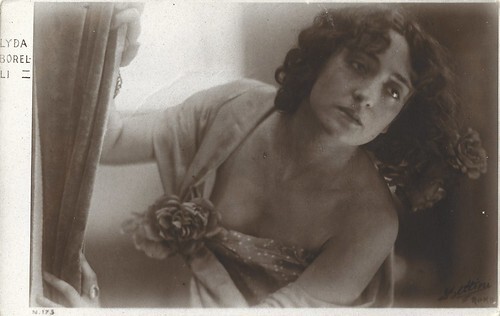
Italian postcard by Ed. Soc. Anon. Bettini, Roma, no. 173. Photo: Riccardo Bettini. Lyda Borelli .
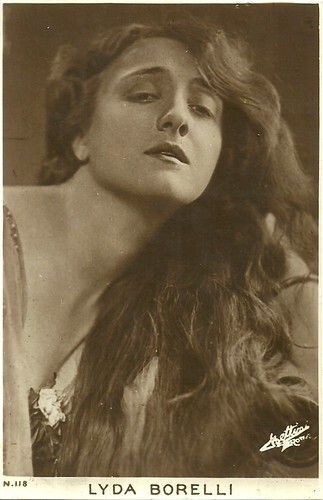
Italian postcard by Ed. Soc. Anon. Bettini, Roma, no. 118. Photo: Riccardo Bettini. Lyda Borelli .
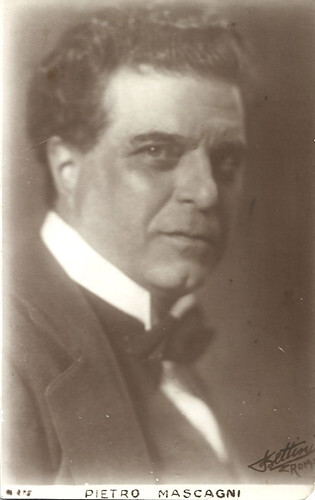
Italian postcard by Ed. Soc. Anon. Bettini, Roma, no. 275. Photo: Riccardo Bettini. Pietro Mascagni.

Italian postcard by Ed. Soc. Anon. Bettini, Roma, no. 158. Photo: Riccardo Bettini. Lyda Borelli .
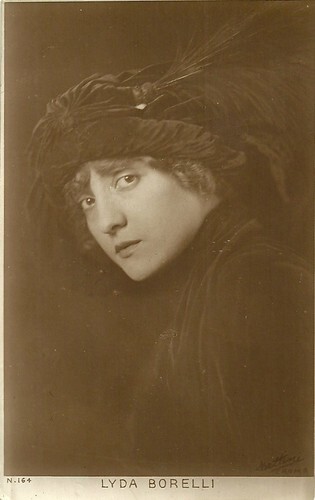
Italian postcard by Ed. Soc. Anon. Bettini, Roma, no. 164. Photo: Riccardo Bettini. Lyda Borelli .
Additional footage, shot to please the maestro
Rapsodia Satanica/Satan's Rhapsody (1917) was at the time called "a cinematographic poem". This poetic vein can be found in the film's intertitles. The poet Fausto Maria Martini wrote the story of the film, in verse, in collaboration with the director of the Cines, Baron Alberto Fassini, who used the pseudonym Alfa. The old Contessa Alba d'Oltrevita ( Lyda Borelli ) deplores her faded youth after a party at her castle. Mephisto (Ugo Bazzini) steps out of a painting and offers her a pact: if she denies love, he will make her young again. She destroys a statuette of Love to confirm her renouncement (yet, the sculpture was not entirely broken). Alba changes into youthful splendour and enjoys the company of young men, in particular the two brothers Tristano ( André Habay a.k.a. Andrea Habay ) and Sergio (Giovanni Cini). Sergio is head over heels in love with her, but she laughs him off.
During a costumed ball, in which Alba is dressed as Salome, she gets a note from Sergio, telling her to come out at midnight or he will kill himself. The capricious Alba then seduces Tristano and forces him to choose: either he or his brother will have her. He goes mad and prevents her from going outside. A shot is heard: Sergio has killed himself. Tristano and Alba are shocked, she pushes him away and closes the castle to mourn her loss. After a while she notices Spring has arrived and revives, covering her rooms with flowers. At nighttime, she notices there is a cavalier on the hills. Could it be Tristano returning? She dresses up like a priestess and goes outside, expecting her lover. But instead, it is Mephisto who punishes her for falling in love and changes her back into the old lady. When she sees herself in the pond, she dies of a heart attack.
As Anthony Kobal writes on IMDb , "Rapsodia satanica was the last film directed by Nino Oxilia and is undoubtedly one of the finest achievements of the early Italian cinema. In it, Oxilia spins a variation on the Faust myth, embodied here by the diva Lyda Borelli. Typical of extravagant D'Annunzian aestheticism at its height, Rapsodia Satanica was one of the summits of what was later called the 'tail coat film'. Diametrically opposed to the "cinema of reality" practised by Serena, Martoglio and others, 'tail coat films' set their melodramatic stories in the salons and villas of the upper middle class and the aristocracy, deploying narrative structures contrived to showcase their actors and especially its actresses. This had the effect of accentuating their physical presence and turning them into stars - probably the first stars in movie history. The success of the "diva" contributed to the development of motion picture grammar in its special use of the close-up."
Rapsodia satanica (Nino Oxilia, 1917) was the first and only film to feature a score written especially for it by famous Italian composer Pietro Mascagni (1863-1945) primarily known for his operas. His masterpiece 'Cavalleria rusticana' (1890) caused one of the greatest sensations in opera history and single-handedly ushered in the Verismo movement in Italian dramatic music. Mascagni wrote fifteen operas, an operetta, several orchestral and vocal works, and also songs and piano music. Pietro Mascagni was probably the first composer to write a full score for an Italian feature film. Director Nino Oxilia had started shooting the film already in 1914. In 1915, Mascagni signed an exclusive contract with Cines to compose music for a film. Originally, Mascagni was to write a score for a film based on the life of Giuseppe Garibaldi, but the scenario by the socialist parliamentarian Enrico Ferri turned out to be too boring, too historical and, according to Mascagni, lacked lyricism. The project was cancelled. After that, three films were presented to Mascagni, of which Mascagni selected Rapsodia satanica, but under various conditions. The main condition was that the last part be entirely refilmed. Oxilia filmed additional footage shot to please the maestro.
Rapsodia satanica was ready in 1915. The film was presented for the press at the Augusteo in Rome and enthusiastically acclaimed by the critics. For reasons unknown, the film did not receive a censorship visa until June 1917. The official premiere took place on 5 July 1917, again at the Augusteo, but in the middle of Summer: audiences and critics had gone on holiday. More than sixty years later, in the 1980s the film was rediscovered. In the Netherlands, the film was included in the retrospective Hartstocht en heldendom: Il primo cinema italiano, 1905-1945 (1988), co-organised by Ivo Blom and Nelly Voorhuis. Only a black-and-white version was available at the time. In 1996, a part monochrome tinted and toned, and part hand-coloured version was found at the Cinémathèque Suisse in Lausanne. Thanks to the film archives of Bologna, Milan and Lausanne the film was analogue restored. In 2015 the film was digitally restored in 4K by Bologna and Lausanne. In 2018 Cineteca di Bologna released the 4-films-DVD Dive!, which includes Rapsodia satanica, with the music by Pietro Mascagni.
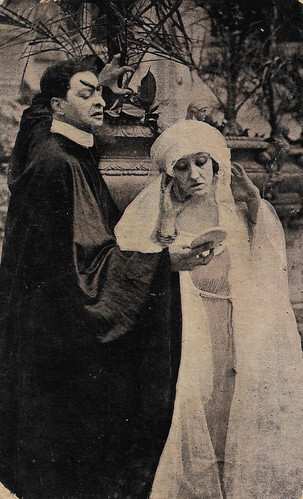
Spanish cromo by Chocolate Pi, Barcelona, no. 1 of 6 cards. Photo: Cines / J. Muntañola. Lyda Borelli and Ugo Bazzini in Rapsodia satanica (Nino Oxilia, 1917).
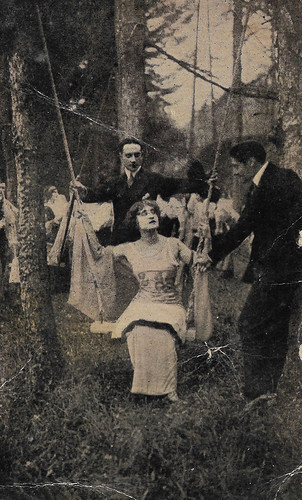
Spanish cromo by Chocolate Pi, Barcelona, no. 2 of 6 cards. Photo: Cines / J. Muntañola. Lyda Borelli , Giovanni Cini and Andrea Habay in Rapsodia satanica (Nino Oxilia, 1917).
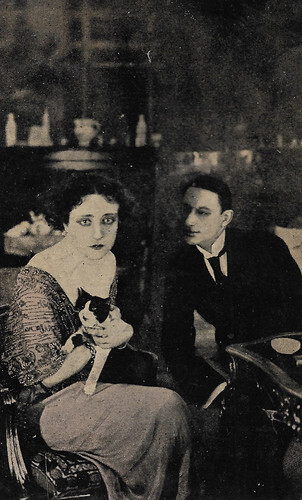
Spanish cromo by Chocolate Pi, Barcelona, no. 3 of 6 cards. Photo: Cines / J. Muntañola. Lyda Borelli and Giovanni Cini in Rapsodia satanica (Nino Oxilia, 1917).
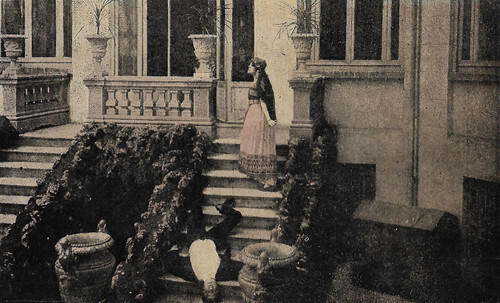
Spanish cromo by Chocolate Pi, Barcelona, no. 4 of 6 cards. Photo: Cines / J. Muntañola. Lyda Borelli and Giovanni Cini in Rapsodia satanica (Nino Oxilia, 1917).
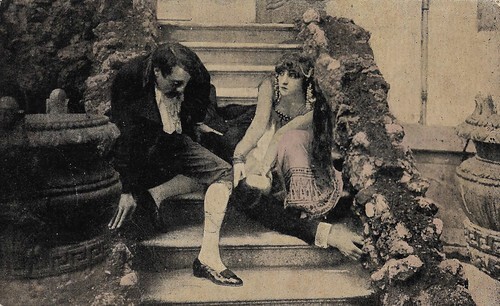
Spanish cromo by Chocolate Pi, Barcelona, no. 5 of 6 cards. Photo: Cines / J. Muntañola. Lyda Borelli , Giovanni Cini and Andrea Habay in Rapsodia satanica (Nino Oxilia, 1917).
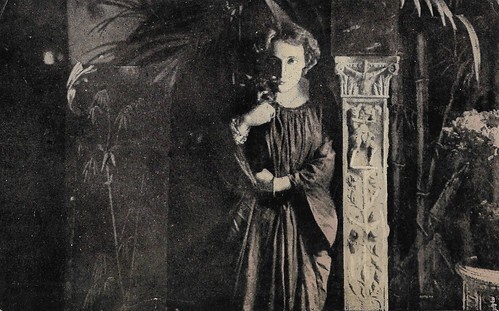
Spanish cromo by Chocolate Pi, Barcelona, no. 6 of 6 cards. Photo: Cines / J. Muntañola. Lyda Borelli in Rapsodia satanica (Nino Oxilia, 1917).
Sources: Le giornate del cinema muto (Italian), Ivo Blom ('Rapsodia satanica', catalogue festival Cinemémoire (1991)), Cinema Ritrovato catalogues 1996 and 2015, Wikipedia (Italian and English) and IMDb.

Italian postcard by Ed. Soc. Anon. Bettini, Roma, no. 173. Photo: Riccardo Bettini. Lyda Borelli .

Italian postcard by Ed. Soc. Anon. Bettini, Roma, no. 118. Photo: Riccardo Bettini. Lyda Borelli .

Italian postcard by Ed. Soc. Anon. Bettini, Roma, no. 275. Photo: Riccardo Bettini. Pietro Mascagni.

Italian postcard by Ed. Soc. Anon. Bettini, Roma, no. 158. Photo: Riccardo Bettini. Lyda Borelli .

Italian postcard by Ed. Soc. Anon. Bettini, Roma, no. 164. Photo: Riccardo Bettini. Lyda Borelli .
Additional footage, shot to please the maestro
Rapsodia Satanica/Satan's Rhapsody (1917) was at the time called "a cinematographic poem". This poetic vein can be found in the film's intertitles. The poet Fausto Maria Martini wrote the story of the film, in verse, in collaboration with the director of the Cines, Baron Alberto Fassini, who used the pseudonym Alfa. The old Contessa Alba d'Oltrevita ( Lyda Borelli ) deplores her faded youth after a party at her castle. Mephisto (Ugo Bazzini) steps out of a painting and offers her a pact: if she denies love, he will make her young again. She destroys a statuette of Love to confirm her renouncement (yet, the sculpture was not entirely broken). Alba changes into youthful splendour and enjoys the company of young men, in particular the two brothers Tristano ( André Habay a.k.a. Andrea Habay ) and Sergio (Giovanni Cini). Sergio is head over heels in love with her, but she laughs him off.
During a costumed ball, in which Alba is dressed as Salome, she gets a note from Sergio, telling her to come out at midnight or he will kill himself. The capricious Alba then seduces Tristano and forces him to choose: either he or his brother will have her. He goes mad and prevents her from going outside. A shot is heard: Sergio has killed himself. Tristano and Alba are shocked, she pushes him away and closes the castle to mourn her loss. After a while she notices Spring has arrived and revives, covering her rooms with flowers. At nighttime, she notices there is a cavalier on the hills. Could it be Tristano returning? She dresses up like a priestess and goes outside, expecting her lover. But instead, it is Mephisto who punishes her for falling in love and changes her back into the old lady. When she sees herself in the pond, she dies of a heart attack.
As Anthony Kobal writes on IMDb , "Rapsodia satanica was the last film directed by Nino Oxilia and is undoubtedly one of the finest achievements of the early Italian cinema. In it, Oxilia spins a variation on the Faust myth, embodied here by the diva Lyda Borelli. Typical of extravagant D'Annunzian aestheticism at its height, Rapsodia Satanica was one of the summits of what was later called the 'tail coat film'. Diametrically opposed to the "cinema of reality" practised by Serena, Martoglio and others, 'tail coat films' set their melodramatic stories in the salons and villas of the upper middle class and the aristocracy, deploying narrative structures contrived to showcase their actors and especially its actresses. This had the effect of accentuating their physical presence and turning them into stars - probably the first stars in movie history. The success of the "diva" contributed to the development of motion picture grammar in its special use of the close-up."
Rapsodia satanica (Nino Oxilia, 1917) was the first and only film to feature a score written especially for it by famous Italian composer Pietro Mascagni (1863-1945) primarily known for his operas. His masterpiece 'Cavalleria rusticana' (1890) caused one of the greatest sensations in opera history and single-handedly ushered in the Verismo movement in Italian dramatic music. Mascagni wrote fifteen operas, an operetta, several orchestral and vocal works, and also songs and piano music. Pietro Mascagni was probably the first composer to write a full score for an Italian feature film. Director Nino Oxilia had started shooting the film already in 1914. In 1915, Mascagni signed an exclusive contract with Cines to compose music for a film. Originally, Mascagni was to write a score for a film based on the life of Giuseppe Garibaldi, but the scenario by the socialist parliamentarian Enrico Ferri turned out to be too boring, too historical and, according to Mascagni, lacked lyricism. The project was cancelled. After that, three films were presented to Mascagni, of which Mascagni selected Rapsodia satanica, but under various conditions. The main condition was that the last part be entirely refilmed. Oxilia filmed additional footage shot to please the maestro.
Rapsodia satanica was ready in 1915. The film was presented for the press at the Augusteo in Rome and enthusiastically acclaimed by the critics. For reasons unknown, the film did not receive a censorship visa until June 1917. The official premiere took place on 5 July 1917, again at the Augusteo, but in the middle of Summer: audiences and critics had gone on holiday. More than sixty years later, in the 1980s the film was rediscovered. In the Netherlands, the film was included in the retrospective Hartstocht en heldendom: Il primo cinema italiano, 1905-1945 (1988), co-organised by Ivo Blom and Nelly Voorhuis. Only a black-and-white version was available at the time. In 1996, a part monochrome tinted and toned, and part hand-coloured version was found at the Cinémathèque Suisse in Lausanne. Thanks to the film archives of Bologna, Milan and Lausanne the film was analogue restored. In 2015 the film was digitally restored in 4K by Bologna and Lausanne. In 2018 Cineteca di Bologna released the 4-films-DVD Dive!, which includes Rapsodia satanica, with the music by Pietro Mascagni.

Spanish cromo by Chocolate Pi, Barcelona, no. 1 of 6 cards. Photo: Cines / J. Muntañola. Lyda Borelli and Ugo Bazzini in Rapsodia satanica (Nino Oxilia, 1917).

Spanish cromo by Chocolate Pi, Barcelona, no. 2 of 6 cards. Photo: Cines / J. Muntañola. Lyda Borelli , Giovanni Cini and Andrea Habay in Rapsodia satanica (Nino Oxilia, 1917).

Spanish cromo by Chocolate Pi, Barcelona, no. 3 of 6 cards. Photo: Cines / J. Muntañola. Lyda Borelli and Giovanni Cini in Rapsodia satanica (Nino Oxilia, 1917).

Spanish cromo by Chocolate Pi, Barcelona, no. 4 of 6 cards. Photo: Cines / J. Muntañola. Lyda Borelli and Giovanni Cini in Rapsodia satanica (Nino Oxilia, 1917).

Spanish cromo by Chocolate Pi, Barcelona, no. 5 of 6 cards. Photo: Cines / J. Muntañola. Lyda Borelli , Giovanni Cini and Andrea Habay in Rapsodia satanica (Nino Oxilia, 1917).

Spanish cromo by Chocolate Pi, Barcelona, no. 6 of 6 cards. Photo: Cines / J. Muntañola. Lyda Borelli in Rapsodia satanica (Nino Oxilia, 1917).
Sources: Le giornate del cinema muto (Italian), Ivo Blom ('Rapsodia satanica', catalogue festival Cinemémoire (1991)), Cinema Ritrovato catalogues 1996 and 2015, Wikipedia (Italian and English) and IMDb.
Published on October 06, 2024 22:00
October 5, 2024
Art direction by Ben Carré
One of the major retrospectives of the 43rd edition of le Giornate del Cinema Muto is dedicated to Ben Carré's activity as a set designer. For King Vidor's classic La Bohème (1925) with John Gilbert and Lilian Gish, Carré designed most of the sets that recreate the Parisian setting of Mimì and Rodolfo's unhappy love story. The beginning and development of Ben Carré's extraordinary career, first in France, at Gaumont with Louis Feuillade, and then in the United States alongside some of the greatest directors, can be retraced in the section curated by Emmy Award-winning set designer Thomas Walsh. Among the titles are rarely-seen classics such as Trilby (1915) and The Blue Bird (1918), the result of Carré's collaboration with Maurice Tourneur.
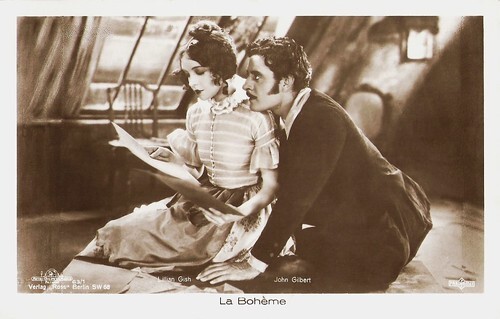
German postcard by Ross Verlag, no. 63/1. Photo: Metro-Goldwyn-Mayer (MGM) / Parufamet. Lillian Gish and John Gilbert in La Bohème (King Vidor, 1926).
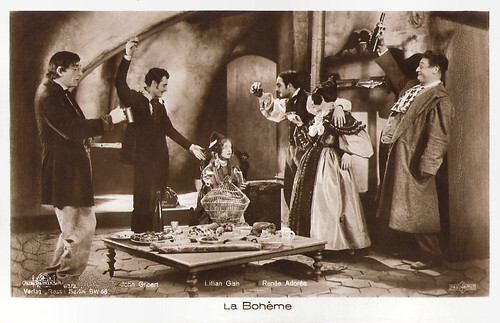
German postcard by Ross Verlag, no. 63/2. Photo: Metro-Goldwyn-Mayer (MGM) / Parufamet. Lillian Gish , John Gilbert and Renée Adorée in La Bohème (King Vidor, 1926).
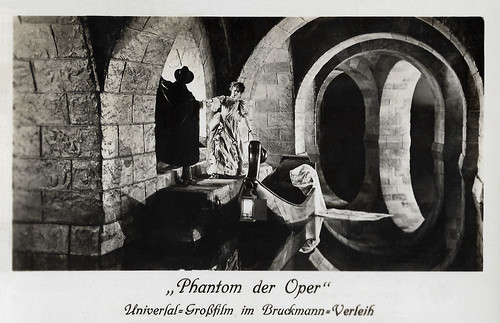
German postcard by Bruckmann-Verleih. Photo: Universal. Lon Chaney and Mary Philbin in The Phantom of the Opera (Rupert Julian, 1925). Caption: Premiere at the Primus Palast 5 November 1925.
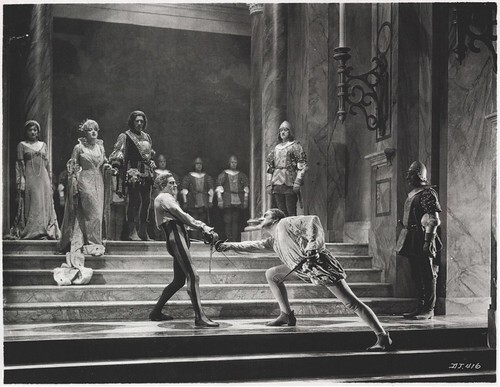
Reproduction of a film still by Warner/ Vitaphone. John Barrymore as Don Juan fights Count Giano Donati (Montague Love), while Cesare Borgia (Warner Oland) and Lucrezia Borgia (Estelle Taylor) look on in Don Juan (Alan Crossland, 1926). Set design by Ben Carré.
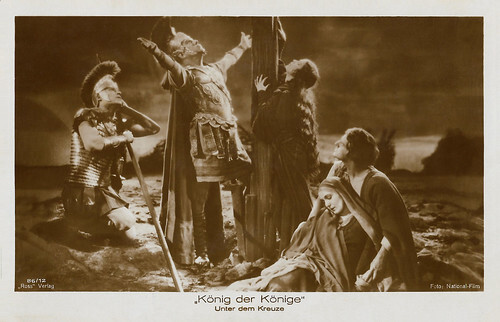
German postcard by Ross Verlag, no. 86/12. Montagu Love as the Captain of the Guards, Jacqueline Logan as Mary Magdelene, Dorothy Cumming as the Virgin Mary, and Joseph Striker as the Apostle John in The King of Kings (Cecil B. DeMille, 1927). Photo: National Film. Caption: Under the Cross.
The creator of the Emerald City
Ben Carré was born Benjamin S. Carré in Paris, France in 1883. His father, a professional painter and decorator, died when Carré was six years old. At thirteen, Carré left school to become an apprentice house painting estimator. Finding his talent lay in painting rather than arithmetic, he took a job as an assistant scene painter at Atelier Amable, at the time one of the most important scenic art studios in Paris. One of his first jobs was painting a large-scale reproduction of the Paris 1900 World's Fair for London's Earl Court Exhibition Hall. Within two years he was designing and painting backgrounds for the Paris Opéra, the Comédie-Française, and Covent Garden in London.
Like many stage designers of the era, Ben Carré was attracted to the burgeoning film industry. In 1905, the then 22-year-old Carré joined Gaumont as a scenic artist. He worked as Messier's assistant in Alice Guy 's last years (1906-1907) at Gaumont before she moved to the U.S. Carré is credited for working as art director on films by Louis Feuillade such as Le Huguenot/The Huguenot (Louis Feuillade, 1909), La Mort de Mozart/Mozart's Last Requiem (Étienne Arnaud, Louis Feuillade, 1909), Le Festin de Balthazar/The Feast of Balthazar (Louis Feuillade, 1910) and Aux lions les chrétiens/The Christian Martyrs (Louis Feuillade, 1911). He overturned previous practice by insisting on painting his sets in colour. Soon after, the rest of Gaumont's scenic artists followed suit, and other studios followed soon after. After seven years at Gaumont, Carré moved to the United States in 1912.
Carré first worked for the American Eclair Film Company, based in New York. Carré was unimpressed by the quality of American production and was reportedly miserable until Maurice Tourneur came along. After director Tourneur emigrated from France in 1914, the pair worked on 31 films together. Carré did the art direction for classic Tourneur films such as the comedy-drama Poor Little Rich Girl (Maurice Tourneur, 1917) starring Mary Pickford , the fantasy The Blue Bird (Maurice Tourneur, 1918), and the adventure drama The Last of the Mohicans (Maurice Tourneur, 1920) with Wallace Beery . Carré also worked for many films with early film stars like Clara Kimball Young, House Peters, Olga Petrova, and Seena Owen.
In the 1920s, Carré worked as a freelance art director. He designed sets for The Red Lily (Fred Niblo, 1924) starring Ramon Novarro and created the catacombs for the Horror film The Phantom of the Opera (Ruper Julian, 1925) starring Lon Chaney . Carré worked on a string of films for the newly formed Metro-Goldwyn-Mayer, starting with The Masked Bride (Christy Cabanne, Josef von Sternberg, 1925) with Mae Murray . He produced key sketches for La Bohème (King Vidor, 1925) but received no screen credit because he left MGM mid-production to join Warner Bros. There he worked on the John Barrymore vehicle Don Juan (Alan Crosland, 1925), the first film to feature a synchronised musical score. At Warner he also designed the sets of the part-talkies Noah's Ark (Michael Curtiz, 1928) and The Jazz Singer (Alan Crosland, 1927) starring Al Jolson , and later also A Night at the Opera (Sam Wood, 1935). He designed the sets of Murnau's City Girl (F.W. Murnau, 1930), and the Golgotha scene in Cecil DeMille 's Biblical epic The King of Kings (1927).
Due primarily to ill health, Ben Carré retired from art direction in 1937 but continued to work on background painting and the creation of miniatures. He created the Emerald City for the Technicolor fantasy The Wizard of Oz (Victor Fleming, 1939) and worked on such classic musicals Meet Me in St. Louis (Vincente Minnelli, 1944), An American in Paris (Vincente Minnelli, 1951), and Singin' in the Rain (Gene Kelly, Stanley Donen, 1952) starring Gene Kelly . He also painted the backgrounds for the historical dramas Marie Antoinette (W. S. Van Dyke, 1938) starring Norma Shearer as the ill-fated Queen of France, and Julius Caesar (Joseph L. Mankiewicz, 1953) with Marlon Brando . Ben Carré retired in 1965 at the age of 82. In addition to his film work, Carré was a prodigious painter and exhibitor of watercolours featuring Los Angeles cityscapes. He also designed murals for the General Motors Pavilion at the New York World's Fair in 1969. He died in 1978 in Santa Monica, California.
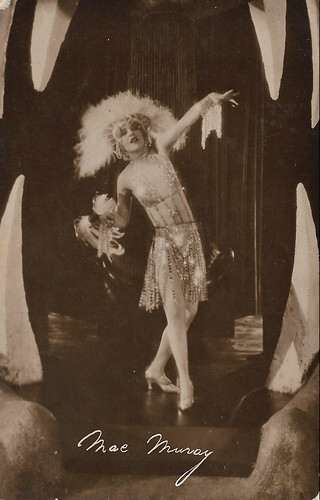
French postcard. Mae Murray in the American silent film The Masked Bride (Christy Cabanne, Joseph von Sternberg. 1925).
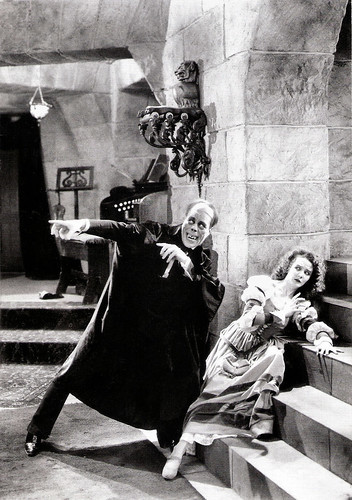
Italian programme card for Il Cinema Ritrovata 2011. Photo: Lon Chaney and Mary Philbin in Phantom of the Opera (Rupert Julian, 1925).
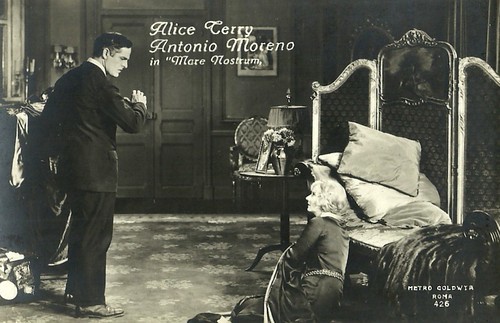
Italian postcard by Ballerini & Fratini, Florence, no. 426. Photo: Metro-Goldwyn, Roma. Antonio Moreno and Alice Terry in Mare Nostrum (Rex Ingram, 1926).
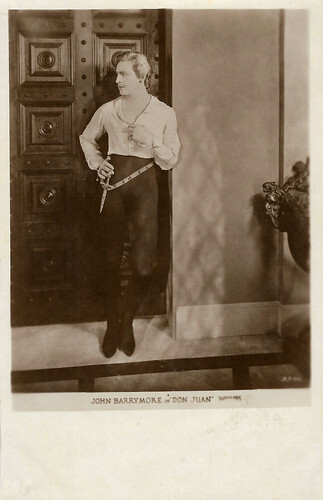
Vintage postcard. Photo: Warner Bros. John Barrymore in Don Juan (Alan Crosland, 1926).
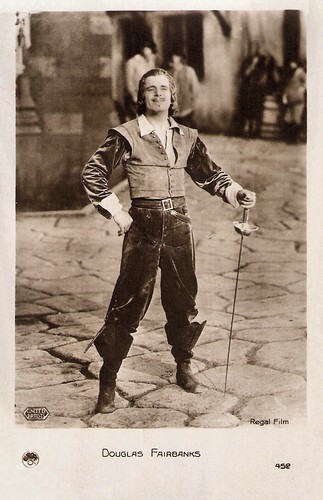
French postcard by Europe, no. 452. Photo: United Artists / Regal Film. Douglas Fairbanks in The Iron Mask (Allan Dwan, 1929).
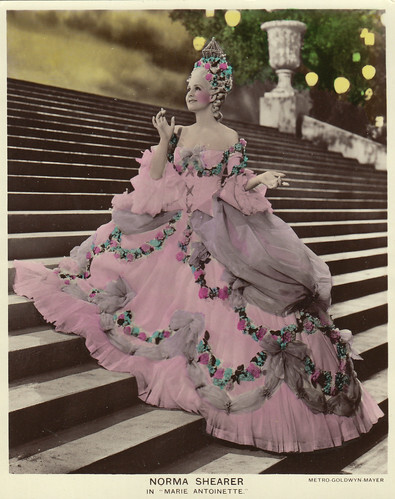
British large card by Picturegoer, in the Colored Art Series, no. CA 8. Photo: Metro-Goldwyn-Mayer. Norma Shearer in Marie-Antoinette (W.S. Van Dyke, 1938). Collection: Marlene Pilaete.
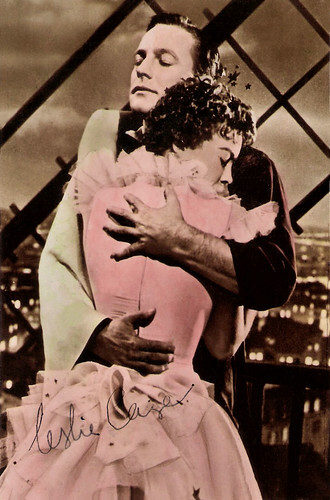
Vintage autograph card. Photo: Leslie Caron and Gene Kelly in An American in Paris (Vincente Minnelli, 1951).
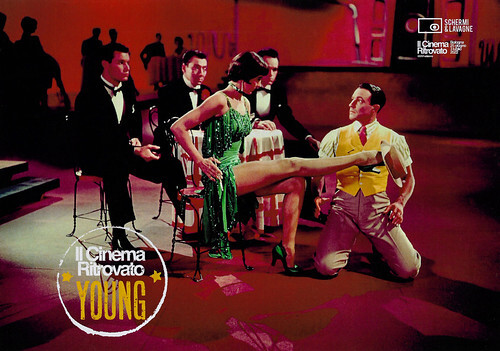
Big programme card by Cineteca Bologna for Il Cinema Ritrovato, XXXVI edizione, Selezione Cinema Ritrovato Young, 2 July 2022. Cyd Charisse and Gene Kelly in Singin' in the Rain (Stanley Donen, Gene Kelly, 1952).
Sources: Thomas Walsh (BenCarré.com), Encyclopedia, (IMDb), le Giornate del Cinema Muto (Italian), Wikipedia (English and French), and IMDb.

German postcard by Ross Verlag, no. 63/1. Photo: Metro-Goldwyn-Mayer (MGM) / Parufamet. Lillian Gish and John Gilbert in La Bohème (King Vidor, 1926).

German postcard by Ross Verlag, no. 63/2. Photo: Metro-Goldwyn-Mayer (MGM) / Parufamet. Lillian Gish , John Gilbert and Renée Adorée in La Bohème (King Vidor, 1926).

German postcard by Bruckmann-Verleih. Photo: Universal. Lon Chaney and Mary Philbin in The Phantom of the Opera (Rupert Julian, 1925). Caption: Premiere at the Primus Palast 5 November 1925.

Reproduction of a film still by Warner/ Vitaphone. John Barrymore as Don Juan fights Count Giano Donati (Montague Love), while Cesare Borgia (Warner Oland) and Lucrezia Borgia (Estelle Taylor) look on in Don Juan (Alan Crossland, 1926). Set design by Ben Carré.

German postcard by Ross Verlag, no. 86/12. Montagu Love as the Captain of the Guards, Jacqueline Logan as Mary Magdelene, Dorothy Cumming as the Virgin Mary, and Joseph Striker as the Apostle John in The King of Kings (Cecil B. DeMille, 1927). Photo: National Film. Caption: Under the Cross.
The creator of the Emerald City
Ben Carré was born Benjamin S. Carré in Paris, France in 1883. His father, a professional painter and decorator, died when Carré was six years old. At thirteen, Carré left school to become an apprentice house painting estimator. Finding his talent lay in painting rather than arithmetic, he took a job as an assistant scene painter at Atelier Amable, at the time one of the most important scenic art studios in Paris. One of his first jobs was painting a large-scale reproduction of the Paris 1900 World's Fair for London's Earl Court Exhibition Hall. Within two years he was designing and painting backgrounds for the Paris Opéra, the Comédie-Française, and Covent Garden in London.
Like many stage designers of the era, Ben Carré was attracted to the burgeoning film industry. In 1905, the then 22-year-old Carré joined Gaumont as a scenic artist. He worked as Messier's assistant in Alice Guy 's last years (1906-1907) at Gaumont before she moved to the U.S. Carré is credited for working as art director on films by Louis Feuillade such as Le Huguenot/The Huguenot (Louis Feuillade, 1909), La Mort de Mozart/Mozart's Last Requiem (Étienne Arnaud, Louis Feuillade, 1909), Le Festin de Balthazar/The Feast of Balthazar (Louis Feuillade, 1910) and Aux lions les chrétiens/The Christian Martyrs (Louis Feuillade, 1911). He overturned previous practice by insisting on painting his sets in colour. Soon after, the rest of Gaumont's scenic artists followed suit, and other studios followed soon after. After seven years at Gaumont, Carré moved to the United States in 1912.
Carré first worked for the American Eclair Film Company, based in New York. Carré was unimpressed by the quality of American production and was reportedly miserable until Maurice Tourneur came along. After director Tourneur emigrated from France in 1914, the pair worked on 31 films together. Carré did the art direction for classic Tourneur films such as the comedy-drama Poor Little Rich Girl (Maurice Tourneur, 1917) starring Mary Pickford , the fantasy The Blue Bird (Maurice Tourneur, 1918), and the adventure drama The Last of the Mohicans (Maurice Tourneur, 1920) with Wallace Beery . Carré also worked for many films with early film stars like Clara Kimball Young, House Peters, Olga Petrova, and Seena Owen.
In the 1920s, Carré worked as a freelance art director. He designed sets for The Red Lily (Fred Niblo, 1924) starring Ramon Novarro and created the catacombs for the Horror film The Phantom of the Opera (Ruper Julian, 1925) starring Lon Chaney . Carré worked on a string of films for the newly formed Metro-Goldwyn-Mayer, starting with The Masked Bride (Christy Cabanne, Josef von Sternberg, 1925) with Mae Murray . He produced key sketches for La Bohème (King Vidor, 1925) but received no screen credit because he left MGM mid-production to join Warner Bros. There he worked on the John Barrymore vehicle Don Juan (Alan Crosland, 1925), the first film to feature a synchronised musical score. At Warner he also designed the sets of the part-talkies Noah's Ark (Michael Curtiz, 1928) and The Jazz Singer (Alan Crosland, 1927) starring Al Jolson , and later also A Night at the Opera (Sam Wood, 1935). He designed the sets of Murnau's City Girl (F.W. Murnau, 1930), and the Golgotha scene in Cecil DeMille 's Biblical epic The King of Kings (1927).
Due primarily to ill health, Ben Carré retired from art direction in 1937 but continued to work on background painting and the creation of miniatures. He created the Emerald City for the Technicolor fantasy The Wizard of Oz (Victor Fleming, 1939) and worked on such classic musicals Meet Me in St. Louis (Vincente Minnelli, 1944), An American in Paris (Vincente Minnelli, 1951), and Singin' in the Rain (Gene Kelly, Stanley Donen, 1952) starring Gene Kelly . He also painted the backgrounds for the historical dramas Marie Antoinette (W. S. Van Dyke, 1938) starring Norma Shearer as the ill-fated Queen of France, and Julius Caesar (Joseph L. Mankiewicz, 1953) with Marlon Brando . Ben Carré retired in 1965 at the age of 82. In addition to his film work, Carré was a prodigious painter and exhibitor of watercolours featuring Los Angeles cityscapes. He also designed murals for the General Motors Pavilion at the New York World's Fair in 1969. He died in 1978 in Santa Monica, California.

French postcard. Mae Murray in the American silent film The Masked Bride (Christy Cabanne, Joseph von Sternberg. 1925).

Italian programme card for Il Cinema Ritrovata 2011. Photo: Lon Chaney and Mary Philbin in Phantom of the Opera (Rupert Julian, 1925).

Italian postcard by Ballerini & Fratini, Florence, no. 426. Photo: Metro-Goldwyn, Roma. Antonio Moreno and Alice Terry in Mare Nostrum (Rex Ingram, 1926).

Vintage postcard. Photo: Warner Bros. John Barrymore in Don Juan (Alan Crosland, 1926).

French postcard by Europe, no. 452. Photo: United Artists / Regal Film. Douglas Fairbanks in The Iron Mask (Allan Dwan, 1929).

British large card by Picturegoer, in the Colored Art Series, no. CA 8. Photo: Metro-Goldwyn-Mayer. Norma Shearer in Marie-Antoinette (W.S. Van Dyke, 1938). Collection: Marlene Pilaete.

Vintage autograph card. Photo: Leslie Caron and Gene Kelly in An American in Paris (Vincente Minnelli, 1951).

Big programme card by Cineteca Bologna for Il Cinema Ritrovato, XXXVI edizione, Selezione Cinema Ritrovato Young, 2 July 2022. Cyd Charisse and Gene Kelly in Singin' in the Rain (Stanley Donen, Gene Kelly, 1952).
Sources: Thomas Walsh (BenCarré.com), Encyclopedia, (IMDb), le Giornate del Cinema Muto (Italian), Wikipedia (English and French), and IMDb.
Published on October 05, 2024 22:00
October 3, 2024
La Gerusalemme liberata (1918)
La Gerusalemme liberata/The Crusaders/Jerusalem Liberated (1918) was an Italian silent period piece directed and produced by Enrico Guazzoni. It was an adaptation of an epic poem by Torquato Tasso from 1581 in the late Renaissance. It tells of Christian knights battling Muslims during the First Crusade of 1096 in the Middle Ages, to retake the holy city of Jerusalem. EFSP presents two series of vintage cards made for the film adaptation. Six Spanish cromos in colour were made by Chocolate Imperial when the film was distributed in Spain by José Montañola under the Spanish title 'Jerusalén Libertada'. The other series is a complete set of 12 original Italian postcards by IPA CT Duplex.
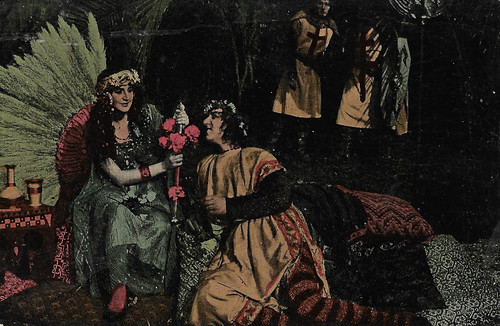
Spanish cromo (collector card) by Chocolate Imperial, no. 1 of 6 cards. Photo: Exclusiva José Montañola / Guazzoni Film. Edy Darclea as Armida and Beppo Corradi as Rinaldo in La Gerusalemme liberata/The Crusaders/Jerusalem Liberated (Enrico Guazzoni, 1918).
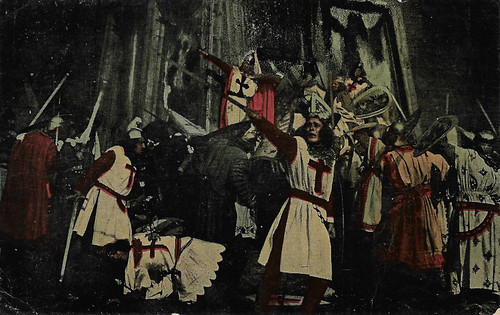
Spanish cromo (collector card) by Chocolate Imperial, no. 2 of 6. The attack on Jerusalem in La Gerusalemme liberata/The Crusaders (Enrico Guazzoni, 1918).
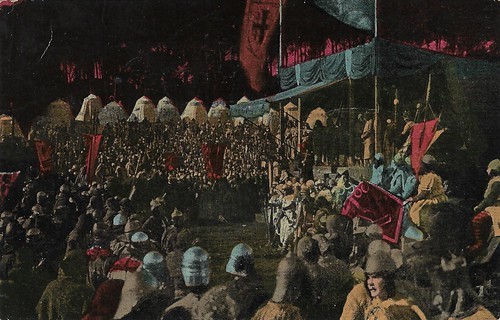
Spanish cromo (collector card) by Chocolate Imperial, no. 3 of 6 cards. The Crusaders' camp in La Gerusalemme liberata/The Crusaders (Enrico Guazzoni, 1918).
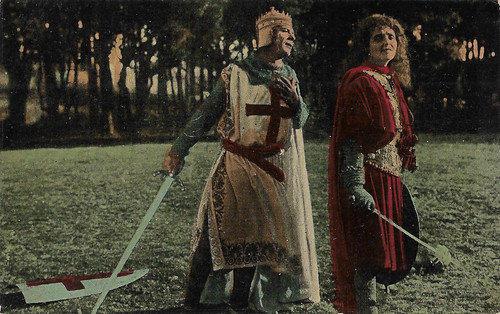
Spanish cromo (collector card) by Chocolate Imperial, no. 4 of 6 cards. Amleto Novelli as Tancredi and Olga Benetti as Clorinda in La Gerusalemme liberata/The Crusaders (Enrico Guazzoni, 1918).
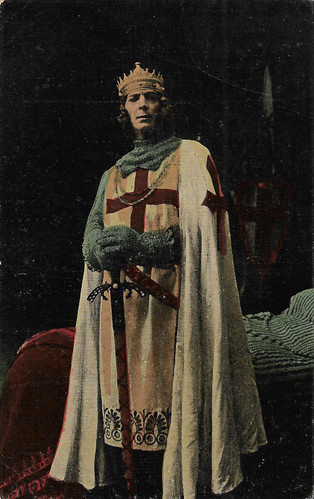
Spanish cromo (collector card) by Chocolate Imperial, no. 5 of 6 cards. Amleto Novelli as Tancredi in La Gerusalemme liberata/The Crusaders (Enrico Guazzoni, 1918).
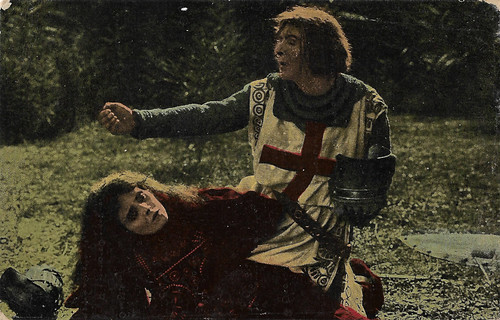
Spanish cromo (collector card) by Chocolate Imperial, no. 6 of 6 cards. Amleto Novelli as Tancredi and Olga Benetti as Clorinda in La Gerusalemme liberata/The Crusaders (Enrico Guazzoni, 1918).
The master of the revocation of famous historical events
In 1096 Godfrey of Bouillon (Eduardo Monteneve) heads a crusade against the Turks and Aladdin (Ljubomir Stanojevick), the cruel king of Jerusalem. His captains are Tancredi ( Amleto Novelli ) from Taranto and Rinaldo from Este. Aladin appoints Clorinda ( Olga Benetti ), an intrepid Persian, to head the troupes defending the city, together with the valiant Argante (Aristide Garbini).
After having saved the lives of Olindo (Rinaldo Rinaldi) and Sofronia, two young Christians condemned to death by the ruthless Aladdin for stealing a sacred image from the mosque, Clorinda fights a duel with Tancredi ( Amleto Novelli ), one of Godfrey's captains. He has fallen in love with her but doesn't want to fight her on the battlefield. Because of her armour and the darkness, he is ignorant of who he is his adversary. So, he kills his beloved, who converts to Christianity while dying.
Meanwhile, the beautiful magician Armida ( Edy Darclea ) has enchanted Rinaldo (Beppo Corradi), another crusader, who has fallen in love with her, in her magical garden. Once he re-awakes from the spell, despite the pleas of Armida, he returns to the Christian camp to participate in the assault of Jerusalem, which is conquered after a long and strenuous battle.
The British film journal The Bioscope wrote in 1919 that Gerusalemme liberata confirmed director Enrico Guazzoni's talent after his Quo vadis?. The Bioscope considered Guazzoni the master of the revocation of such famous historical events, even more than D.W. Griffith . While most attention went to the mass scenes, individual praise was for Novelli and Benetti. The triumphant entry into Jerusalem was equaled to the victorious entry of the Allies, 800 years after.
In 1911 Enrico Guazzoni already made an earlier version, again with Amleto Novelli in the lead as Tancredi, but this time also with Gianna Terribili Gonzales as Clorinda, instead of Olga Benetti . In this version, Emilio Ghione played Rinaldo, and Fernanda Negri-Pouget was Armida. Wikipedia mixes up these two versions and mistakes its production year. The 1911 version was well received, nationally and internationally, and considered the second Italian 'feat' after La caduta di Troia/The Fall Of Troy (Giovanni Pastrone, 1911), the first two-reeler epic film. In 1934, Guazzoni re-issued his 1918 version in a 'spoken' and re-cut version with scenes added. The dialogues were written by Fausto Salvadori and an introductory commentary was done by Adolfo Geri who played Torquato Tasso. The version lasted about twenty minutes longer than the silent version and the music was by Luigi Avitabile.
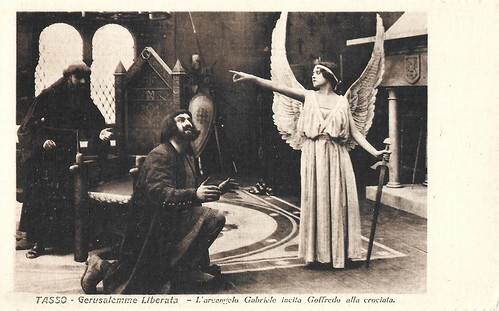
Italian postcard by IPA CT Duplex, card 1 of a series of 12. Photo: Guazzoni Film, Roma. Scene from La Gerusalemme liberata/The Crusaders/Jerusalem Liberated (Enrico Guazzoni, 1918). Caption: The archangel Gabriel incites Godfrey to go on a crusade. Eduardo Monteneve plays Godfrey of Bouillon, while Gabriel might have been played by the actress Fernanda Negri Pouget .
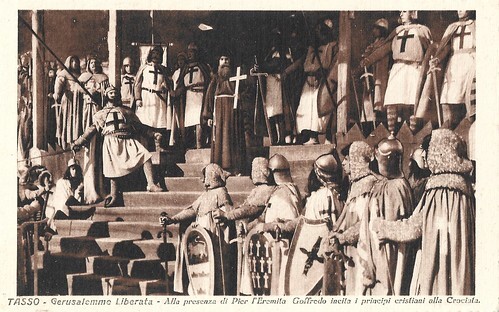
Italian postcard by IPA CT Duplex, card 2 of a series of 12. Photo: Guazzoni Film, Roma. Scene from La Gerusalemme liberata/The Crusaders (Enrico Guazzoni, 1918). Caption: In the presence of Peter the Hermite, Godfrey incites the Christian knights to join the Crusade. Godfrey of Bouillon was performed by Eduardo Monteneve.
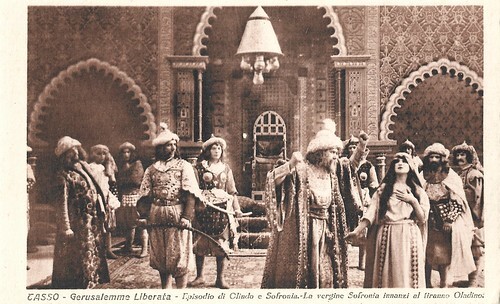
Italian postcard by IPA CT Duplex, card 3 of a series of 12. Photo: Guazzoni Film, Roma. Scene from La Gerusalemme liberata/The Crusaders (Enrico Guazzoni, 1918). Caption: Episode of Olindo and Sofronia. The virgin Sofronia before the tyrant Aladin. Ljubomir Stanojevic played Aladin, and Rinaldo Rinaldi played Olindo, but it isn't clear who played Sofronia.
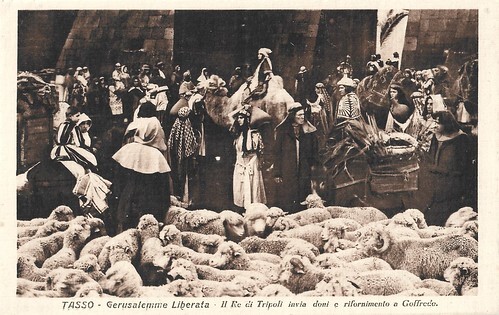
Italian postcard by IPA CT Duplex, card 4 of a series of 12. Photo: Guazzoni Film, Roma. Scene from La Gerusalemme liberata/The Crusaders (Enrico Guazzoni, 1918). Caption: The King of Tripoli sends gifts and supplies to Goffredo.
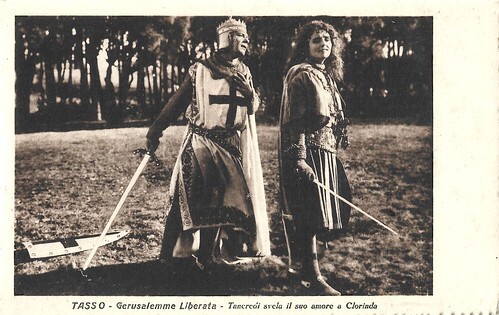
Italian postcard by IPA CT Duplex, card 5 of a series of 12. Photo: Guazzoni Film, Roma. Scene from La Gerusalemme liberata/The Crusaders (Enrico Guazzoni, 1918). Caption: Tancredi reveals his love for Clorinda. Tancredi was played by Amleto Novelli and Clorinda by Olga Benetti .
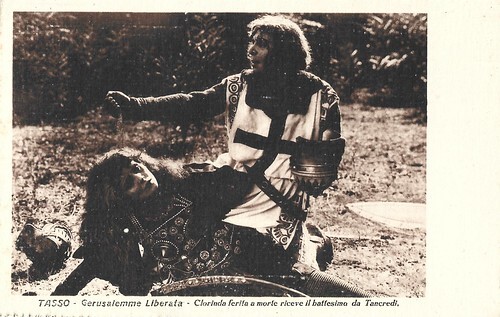
Italian postcard by IPA CT Duplex, card 6 of a series of 12. Photo: Guazzoni Film, Roma. Scene from La Gerusalemme liberata/The Crusaders (Enrico Guazzoni, 1918). Caption: The mortally wounded Clorinda is baptised by Tancredi. Olga Benetti played Clorinda and Amleto Novelli Tancredi.
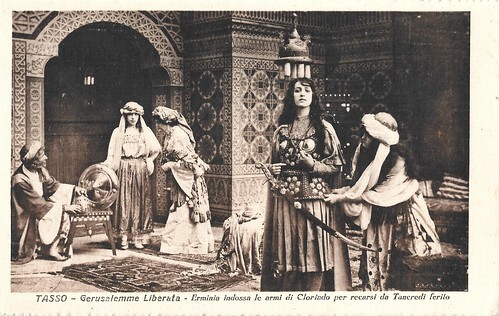
Italian postcard by IPA CT Duplex, card 7 of a series of 12. Photo: Guazzoni Film, Roma. Scene from La Gerusalemme liberata/ The Crusaders (Enrico Guazzoni, 1918). Caption: Erminia wears the armour of Clorinda before going to the wounded Tancredi. Elena Sangro played Erminia.
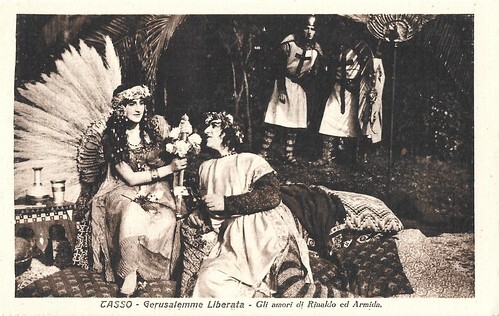
Italian postcard by IPA CT Duplex, card 8 of a series of 12. Photo: Guazzoni Film, Roma. Scene from La Gerusalemme liberata/ The Crusaders (Enrico Guazzoni, 1918). Caption: The loves of Rinaldo and Armida. Beppo Corradi plays Rinaldo, Edy Darclea Armida.
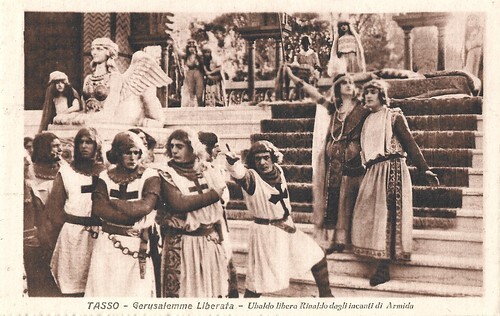
Italian postcard by IPA CT Duplex, card 9 of a series of 12. Photo: Guazzoni Film, Roma. Scene from La Gerusalemme liberata/The Crusaders (Enrico Guazzoni, 1918). Caption: Ubaldo liberates Rinaldo from the spells of Armida. Of the stairs, Edy Darclea as Armida and Beppo Corradi as Rinaldo. The man gesticulating in the middle is Amleto Novelli , who plays Tancredi.
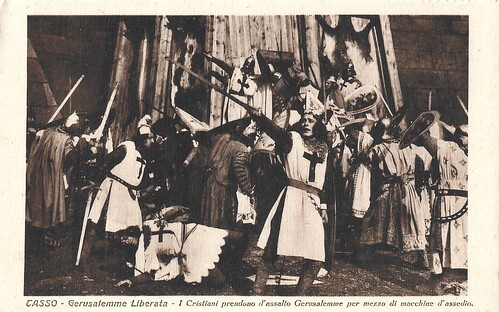
Italian postcard by IPA CT Duplex, card 10 of a series of 12. Photo: Guazzoni Film, Roma. Scene from La Gerusalemme liberata/The Crusaders (Enrico Guazzoni, 1918). Caption: The Christians attack Jerusalem with their siege machinery.
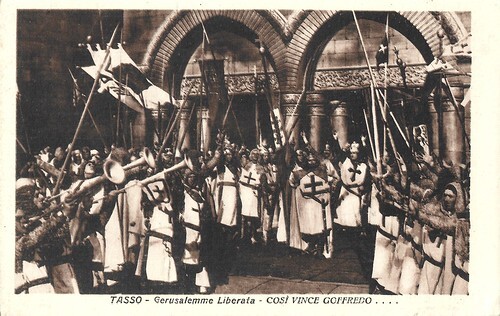
Italian postcard by IPA CT Duplex, card 11 of a series of 12. Photo: Guazzoni Film, Roma. Scene from the Italian silent film La Gerusalemme liberata/The Crusaders (Enrico Guazzoni, 1918). Caption: Thus Godfrey wins. Goffredo di Buglione/Godfrey of Bouillon was performed by Eduardo Monteneve.
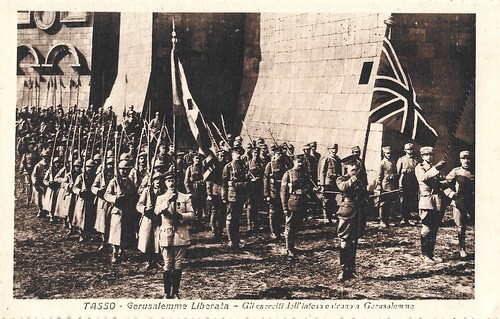
Italian postcard by IPA CT Duplex, no. 12 of a series of 12. Photo: Guazzoni Film, Roma. Scene from the Italian silent film La Gerusalemme liberata/Jerusalem liberated/The Crusaders (Enrico Guazzoni, 1918). Caption: The Allied armies enter Jerusalem (during WW I).
Sources: Vittorio Martinelli (Il cinema muto italiano, Vol. 1918 (1991), and Vol. 1911, I (1995)), Wikipedia (English and Italian) and IMDb.

Spanish cromo (collector card) by Chocolate Imperial, no. 1 of 6 cards. Photo: Exclusiva José Montañola / Guazzoni Film. Edy Darclea as Armida and Beppo Corradi as Rinaldo in La Gerusalemme liberata/The Crusaders/Jerusalem Liberated (Enrico Guazzoni, 1918).

Spanish cromo (collector card) by Chocolate Imperial, no. 2 of 6. The attack on Jerusalem in La Gerusalemme liberata/The Crusaders (Enrico Guazzoni, 1918).

Spanish cromo (collector card) by Chocolate Imperial, no. 3 of 6 cards. The Crusaders' camp in La Gerusalemme liberata/The Crusaders (Enrico Guazzoni, 1918).

Spanish cromo (collector card) by Chocolate Imperial, no. 4 of 6 cards. Amleto Novelli as Tancredi and Olga Benetti as Clorinda in La Gerusalemme liberata/The Crusaders (Enrico Guazzoni, 1918).

Spanish cromo (collector card) by Chocolate Imperial, no. 5 of 6 cards. Amleto Novelli as Tancredi in La Gerusalemme liberata/The Crusaders (Enrico Guazzoni, 1918).

Spanish cromo (collector card) by Chocolate Imperial, no. 6 of 6 cards. Amleto Novelli as Tancredi and Olga Benetti as Clorinda in La Gerusalemme liberata/The Crusaders (Enrico Guazzoni, 1918).
The master of the revocation of famous historical events
In 1096 Godfrey of Bouillon (Eduardo Monteneve) heads a crusade against the Turks and Aladdin (Ljubomir Stanojevick), the cruel king of Jerusalem. His captains are Tancredi ( Amleto Novelli ) from Taranto and Rinaldo from Este. Aladin appoints Clorinda ( Olga Benetti ), an intrepid Persian, to head the troupes defending the city, together with the valiant Argante (Aristide Garbini).
After having saved the lives of Olindo (Rinaldo Rinaldi) and Sofronia, two young Christians condemned to death by the ruthless Aladdin for stealing a sacred image from the mosque, Clorinda fights a duel with Tancredi ( Amleto Novelli ), one of Godfrey's captains. He has fallen in love with her but doesn't want to fight her on the battlefield. Because of her armour and the darkness, he is ignorant of who he is his adversary. So, he kills his beloved, who converts to Christianity while dying.
Meanwhile, the beautiful magician Armida ( Edy Darclea ) has enchanted Rinaldo (Beppo Corradi), another crusader, who has fallen in love with her, in her magical garden. Once he re-awakes from the spell, despite the pleas of Armida, he returns to the Christian camp to participate in the assault of Jerusalem, which is conquered after a long and strenuous battle.
The British film journal The Bioscope wrote in 1919 that Gerusalemme liberata confirmed director Enrico Guazzoni's talent after his Quo vadis?. The Bioscope considered Guazzoni the master of the revocation of such famous historical events, even more than D.W. Griffith . While most attention went to the mass scenes, individual praise was for Novelli and Benetti. The triumphant entry into Jerusalem was equaled to the victorious entry of the Allies, 800 years after.
In 1911 Enrico Guazzoni already made an earlier version, again with Amleto Novelli in the lead as Tancredi, but this time also with Gianna Terribili Gonzales as Clorinda, instead of Olga Benetti . In this version, Emilio Ghione played Rinaldo, and Fernanda Negri-Pouget was Armida. Wikipedia mixes up these two versions and mistakes its production year. The 1911 version was well received, nationally and internationally, and considered the second Italian 'feat' after La caduta di Troia/The Fall Of Troy (Giovanni Pastrone, 1911), the first two-reeler epic film. In 1934, Guazzoni re-issued his 1918 version in a 'spoken' and re-cut version with scenes added. The dialogues were written by Fausto Salvadori and an introductory commentary was done by Adolfo Geri who played Torquato Tasso. The version lasted about twenty minutes longer than the silent version and the music was by Luigi Avitabile.

Italian postcard by IPA CT Duplex, card 1 of a series of 12. Photo: Guazzoni Film, Roma. Scene from La Gerusalemme liberata/The Crusaders/Jerusalem Liberated (Enrico Guazzoni, 1918). Caption: The archangel Gabriel incites Godfrey to go on a crusade. Eduardo Monteneve plays Godfrey of Bouillon, while Gabriel might have been played by the actress Fernanda Negri Pouget .

Italian postcard by IPA CT Duplex, card 2 of a series of 12. Photo: Guazzoni Film, Roma. Scene from La Gerusalemme liberata/The Crusaders (Enrico Guazzoni, 1918). Caption: In the presence of Peter the Hermite, Godfrey incites the Christian knights to join the Crusade. Godfrey of Bouillon was performed by Eduardo Monteneve.

Italian postcard by IPA CT Duplex, card 3 of a series of 12. Photo: Guazzoni Film, Roma. Scene from La Gerusalemme liberata/The Crusaders (Enrico Guazzoni, 1918). Caption: Episode of Olindo and Sofronia. The virgin Sofronia before the tyrant Aladin. Ljubomir Stanojevic played Aladin, and Rinaldo Rinaldi played Olindo, but it isn't clear who played Sofronia.

Italian postcard by IPA CT Duplex, card 4 of a series of 12. Photo: Guazzoni Film, Roma. Scene from La Gerusalemme liberata/The Crusaders (Enrico Guazzoni, 1918). Caption: The King of Tripoli sends gifts and supplies to Goffredo.

Italian postcard by IPA CT Duplex, card 5 of a series of 12. Photo: Guazzoni Film, Roma. Scene from La Gerusalemme liberata/The Crusaders (Enrico Guazzoni, 1918). Caption: Tancredi reveals his love for Clorinda. Tancredi was played by Amleto Novelli and Clorinda by Olga Benetti .

Italian postcard by IPA CT Duplex, card 6 of a series of 12. Photo: Guazzoni Film, Roma. Scene from La Gerusalemme liberata/The Crusaders (Enrico Guazzoni, 1918). Caption: The mortally wounded Clorinda is baptised by Tancredi. Olga Benetti played Clorinda and Amleto Novelli Tancredi.

Italian postcard by IPA CT Duplex, card 7 of a series of 12. Photo: Guazzoni Film, Roma. Scene from La Gerusalemme liberata/ The Crusaders (Enrico Guazzoni, 1918). Caption: Erminia wears the armour of Clorinda before going to the wounded Tancredi. Elena Sangro played Erminia.

Italian postcard by IPA CT Duplex, card 8 of a series of 12. Photo: Guazzoni Film, Roma. Scene from La Gerusalemme liberata/ The Crusaders (Enrico Guazzoni, 1918). Caption: The loves of Rinaldo and Armida. Beppo Corradi plays Rinaldo, Edy Darclea Armida.

Italian postcard by IPA CT Duplex, card 9 of a series of 12. Photo: Guazzoni Film, Roma. Scene from La Gerusalemme liberata/The Crusaders (Enrico Guazzoni, 1918). Caption: Ubaldo liberates Rinaldo from the spells of Armida. Of the stairs, Edy Darclea as Armida and Beppo Corradi as Rinaldo. The man gesticulating in the middle is Amleto Novelli , who plays Tancredi.

Italian postcard by IPA CT Duplex, card 10 of a series of 12. Photo: Guazzoni Film, Roma. Scene from La Gerusalemme liberata/The Crusaders (Enrico Guazzoni, 1918). Caption: The Christians attack Jerusalem with their siege machinery.

Italian postcard by IPA CT Duplex, card 11 of a series of 12. Photo: Guazzoni Film, Roma. Scene from the Italian silent film La Gerusalemme liberata/The Crusaders (Enrico Guazzoni, 1918). Caption: Thus Godfrey wins. Goffredo di Buglione/Godfrey of Bouillon was performed by Eduardo Monteneve.

Italian postcard by IPA CT Duplex, no. 12 of a series of 12. Photo: Guazzoni Film, Roma. Scene from the Italian silent film La Gerusalemme liberata/Jerusalem liberated/The Crusaders (Enrico Guazzoni, 1918). Caption: The Allied armies enter Jerusalem (during WW I).
Sources: Vittorio Martinelli (Il cinema muto italiano, Vol. 1918 (1991), and Vol. 1911, I (1995)), Wikipedia (English and Italian) and IMDb.
Published on October 03, 2024 22:00
Paul van Yperen's Blog
- Paul van Yperen's profile
- 13 followers
Paul van Yperen isn't a Goodreads Author
(yet),
but they
do have a blog,
so here are some recent posts imported from
their feed.



